-
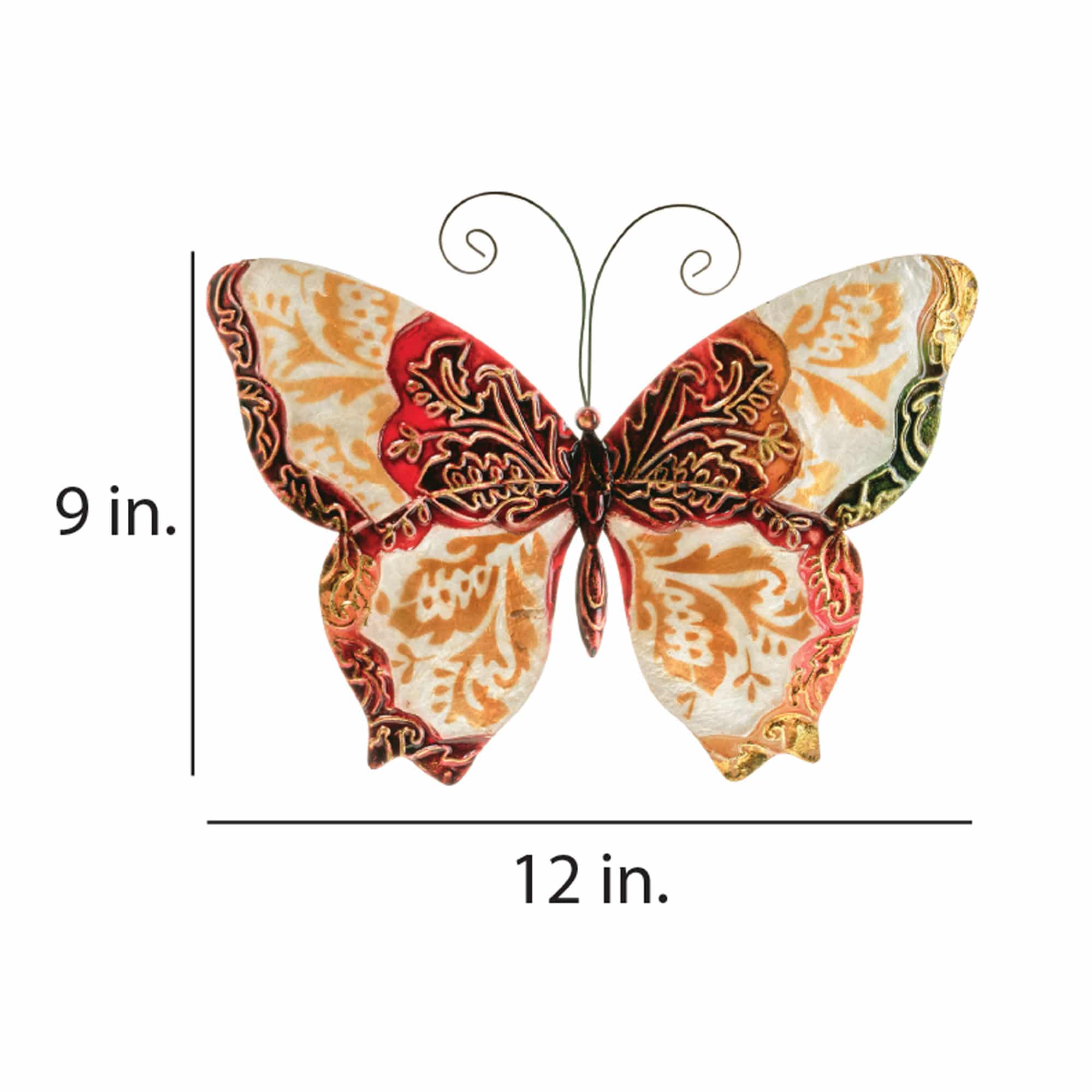
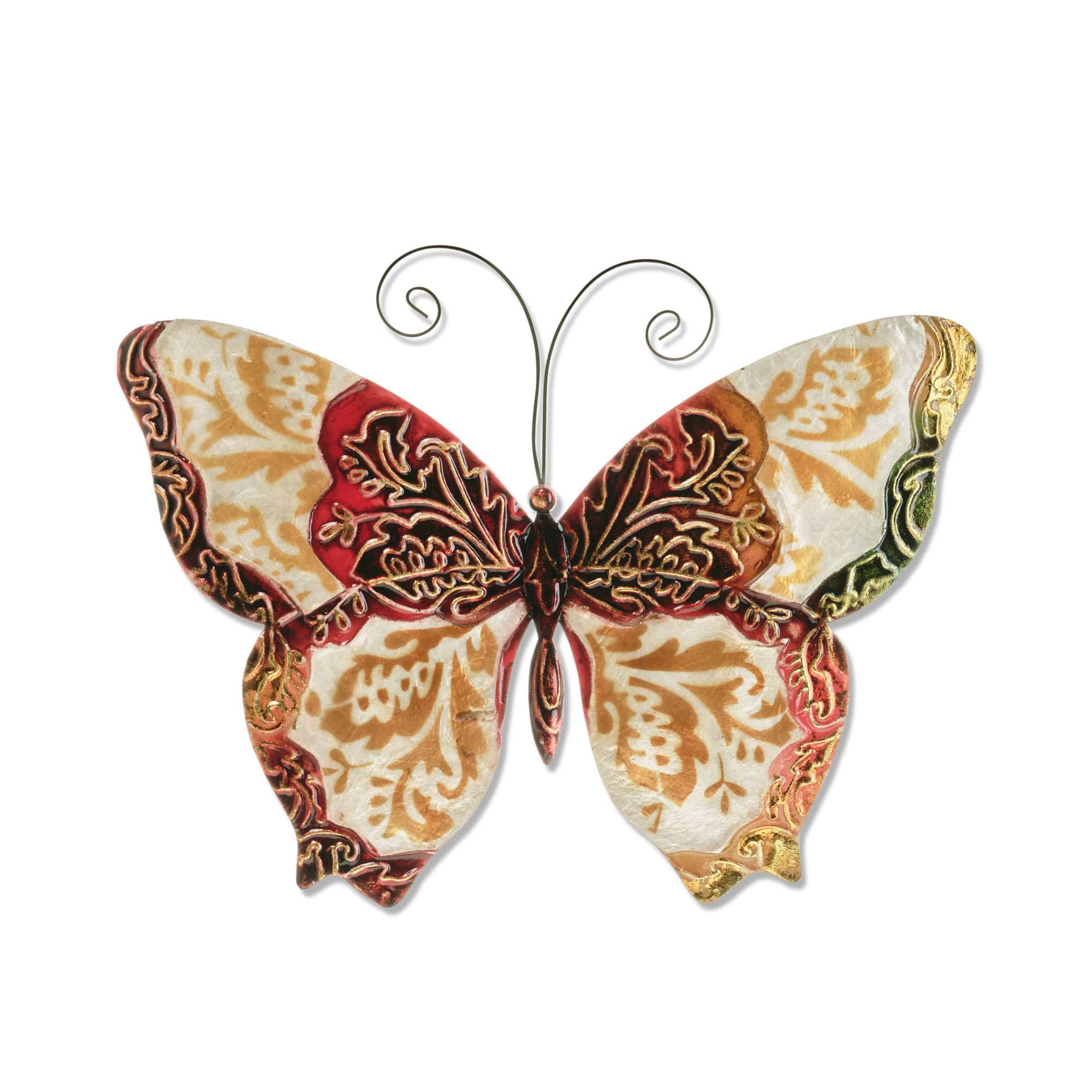 This butterfly can be described as stately, due the artist combination of the color pallet, patterns edged into the tin, and the mix of natural and handcrafted materials. The center of the butterfly is defined with a metallic red, accentuated with a raised pattern painted in gold. The center portion of the wings are crafted using capiz oyster shell, mirroring the patterns of the gold accents. The basic frame of the butterfly is created using tin, which is powder-coated with a black finish and makes this piece safe to use outdoors. The edges of the frame are reinforced using thicker tin wire. The front of this piece is adorned in areas with capiz shell, an oyster native to the Philippines, before being hand-painted and sealed with a water-based sealant. The primary purpose of this oyster to provide a source of food, however, the shell is a sustainable by-product that can be used for decoration. The capiz shell subtly replicates the reflective qualities of butterflies in nature. The entire piece is lightweight and has an eyelet in the back allowing it to be hung using a finishing nail, command strip, or a push pin. Due to it being a natural material, the organic colors of capiz come through as tans and browns underneath the paint.
This butterfly can be described as stately, due the artist combination of the color pallet, patterns edged into the tin, and the mix of natural and handcrafted materials. The center of the butterfly is defined with a metallic red, accentuated with a raised pattern painted in gold. The center portion of the wings are crafted using capiz oyster shell, mirroring the patterns of the gold accents. The basic frame of the butterfly is created using tin, which is powder-coated with a black finish and makes this piece safe to use outdoors. The edges of the frame are reinforced using thicker tin wire. The front of this piece is adorned in areas with capiz shell, an oyster native to the Philippines, before being hand-painted and sealed with a water-based sealant. The primary purpose of this oyster to provide a source of food, however, the shell is a sustainable by-product that can be used for decoration. The capiz shell subtly replicates the reflective qualities of butterflies in nature. The entire piece is lightweight and has an eyelet in the back allowing it to be hung using a finishing nail, command strip, or a push pin. Due to it being a natural material, the organic colors of capiz come through as tans and browns underneath the paint. -
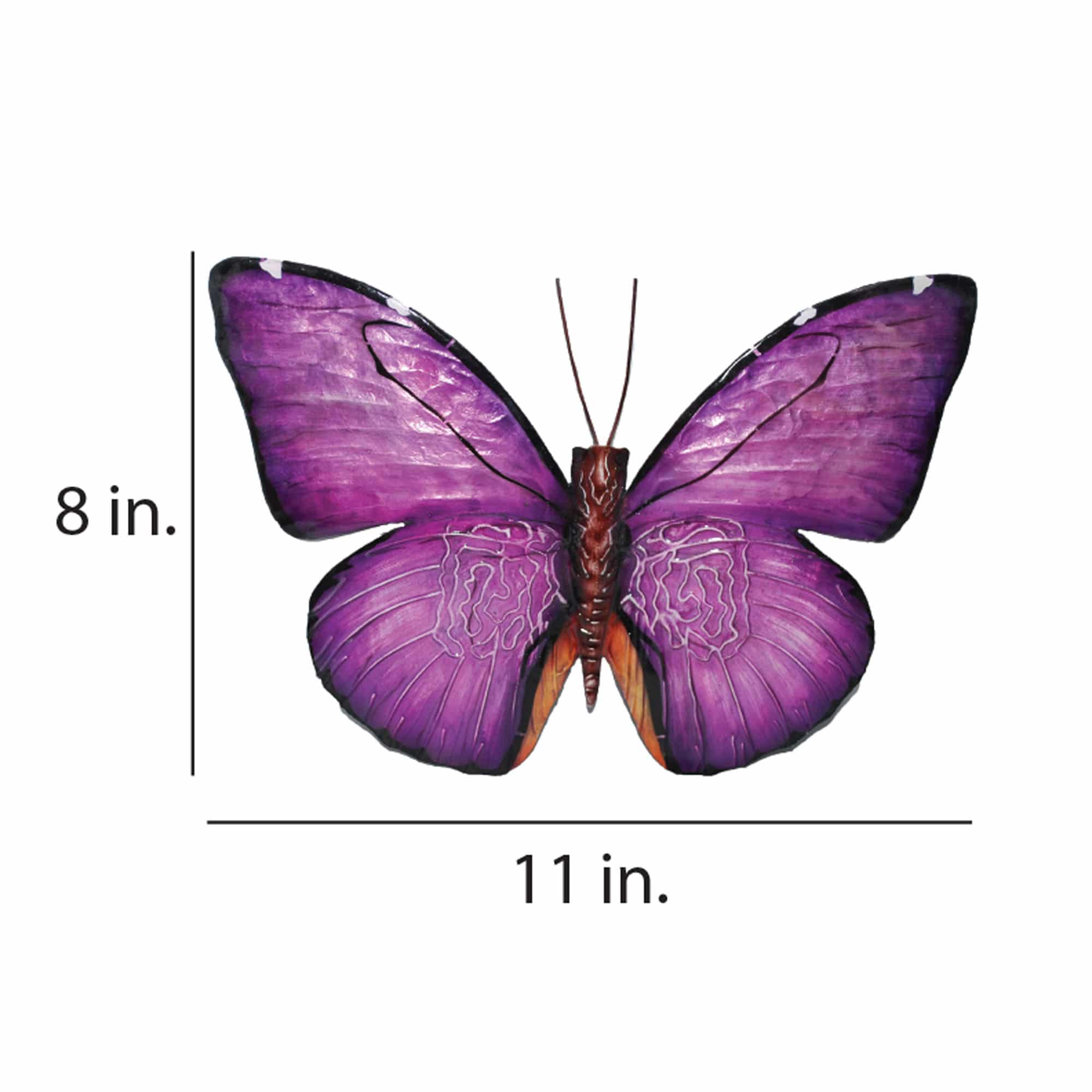
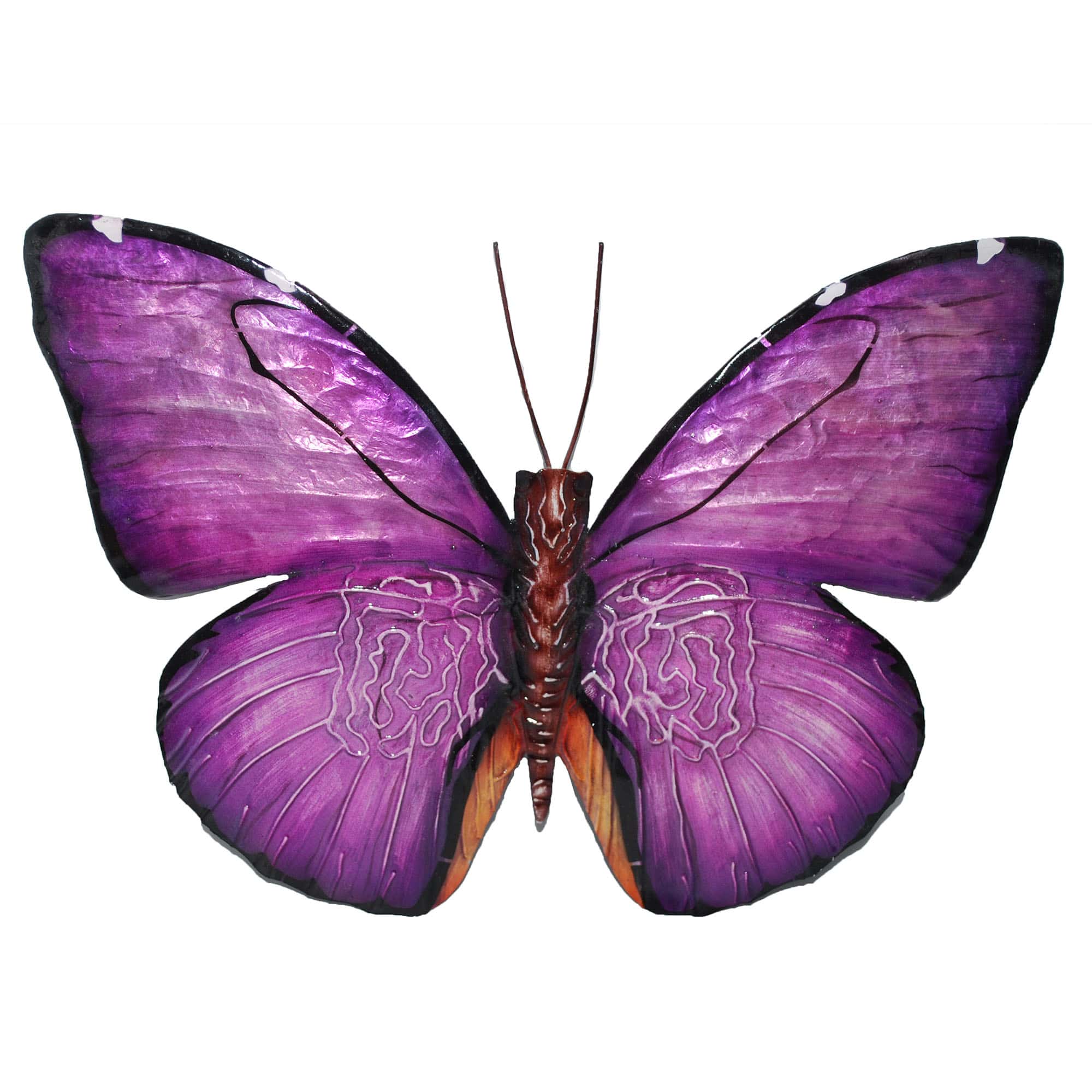
Purple is considered a color of royalty and wealth due to the rarity of the dye that originally produced it. Even though that no longer is the case, it still is considered a bold and rich color. The color is even more vibrant due to the strips of color created by the brush strokes against the capiz shell. The artist complemented the predominantly purple colored butterfly with oranges and reds at the base and a couple of white spots on each wing. If your color is primarily purple or if it is just used as an accent, this butterfly will complement any decor in your room.
The basic frame of the butterfly is created using tin, which is powder-coated with a black finish and makes this piece safe to use outdoors. The edges of the frame are reinforced using thicker tin wire. The front of this piece is adorned in areas with capiz shell, an oyster native to the Philippines, before being hand-painted and sealed with a water-based sealant. The primary purpose of this oyster to provide a source of food, however, the shell is a sustainable by-product that can be used for decoration. The capiz shell subtly replicates the reflective qualities of butterflies in nature. The entire piece is lightweight and has an eyelet in the back allowing it to be hung using a finishing nail, command strip, or a push pin. Due to it being a natural material, the organic colors of capiz come through as tans and browns underneath the paint.
-
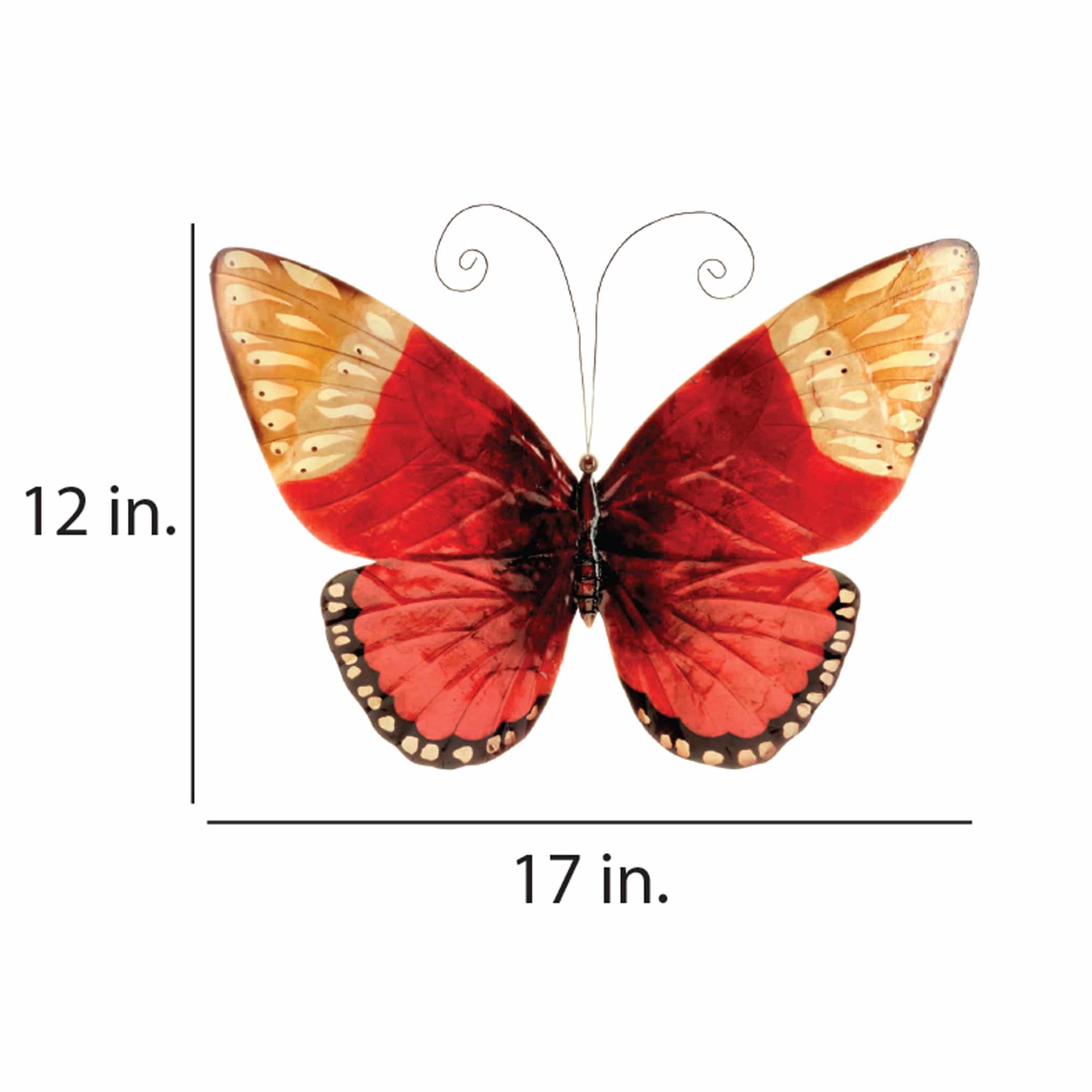
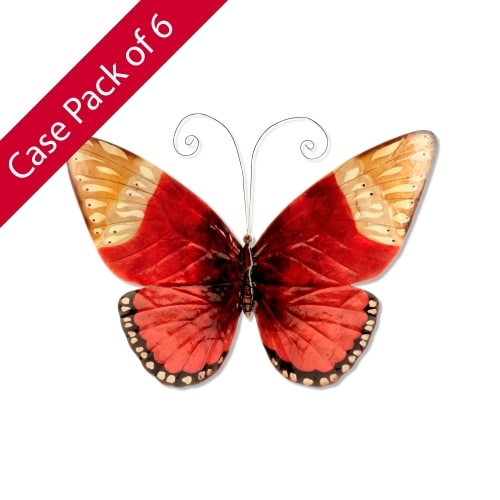 Case of 6
Case of 6This butterfly is large and bold with its striking bright red body. But this butterfly isn't mono-colored. Instead the artist uses different shading techniques and mother of pearl oyster shell to bring in depth as well as strong color. The artist further enhances the butterfly by adding brown feathering to the wing-tips.
The basic frame of the butterfly is created using tin, which is powder-coated with a black finish and makes this piece safe to use outdoors. The edges of the frame are reinforced using thicker tin wire. The front of this piece is adorned in areas with capiz shell, an oyster native to the Philippines, before being hand-painted and sealed with a water-based sealant. The primary purpose of this oyster to provide a source of food, however, the shell is a sustainable by-product that can be used for decoration. The capiz shell subtly replicates the reflective qualities of butterflies in nature. The entire piece is lightweight and has an eyelet in the back allowing it to be hung using a finishing nail, command strip, or a push pin. Due to it being a natural material, the organic colors of capiz come through as tans and browns underneath the paint.
-

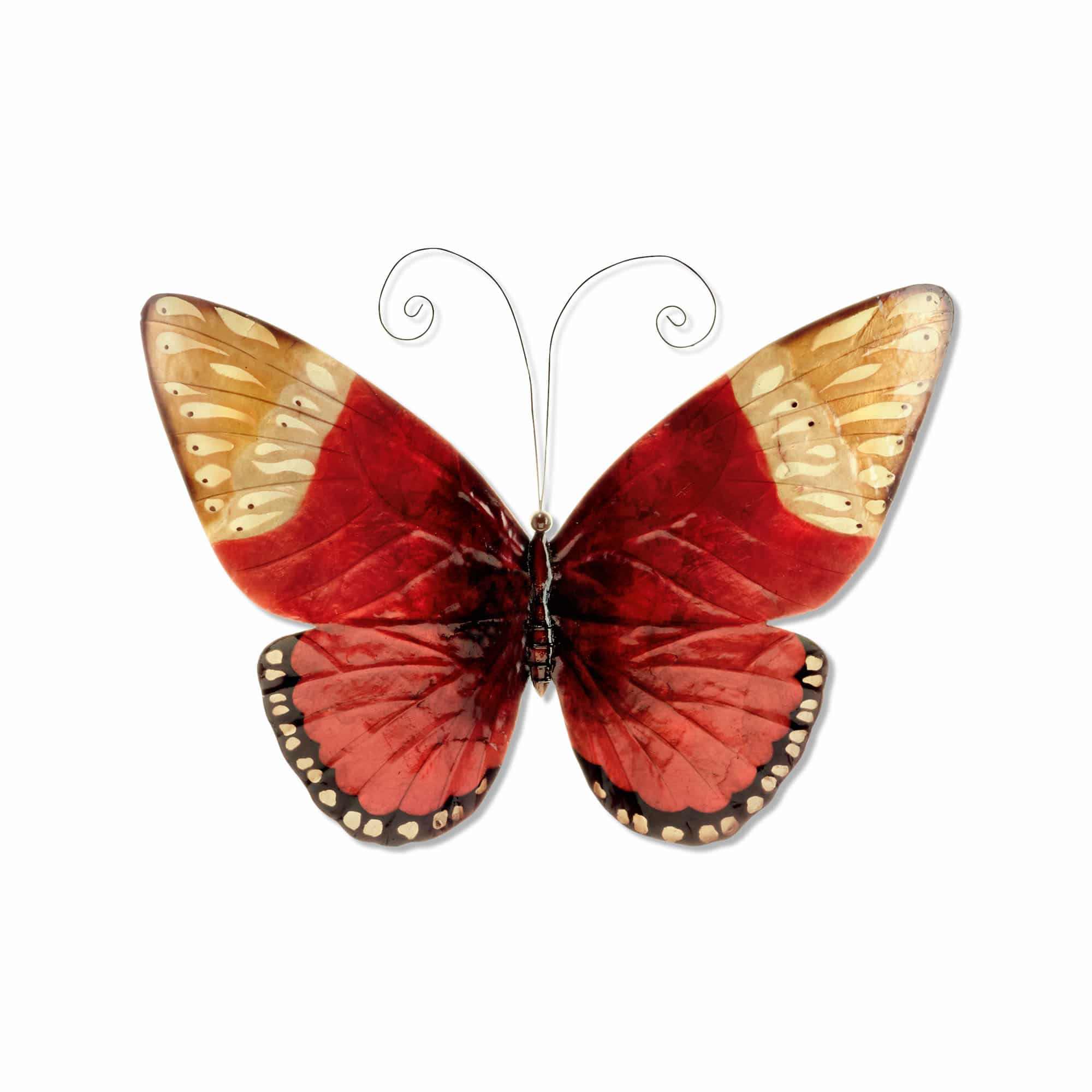
This butterfly is large and bold with its striking bright red body. But this butterfly isn't mono-colored. Instead the artist uses different shading techniques and mother of pearl oyster shell to bring in depth as well as strong color. The artist further enhances the butterfly by adding brown feathering to the wing-tips.
The basic frame of the butterfly is created using tin, which is powder-coated with a black finish and makes this piece safe to use outdoors. The edges of the frame are reinforced using thicker tin wire. The front of this piece is adorned in areas with capiz shell, an oyster native to the Philippines, before being hand-painted and sealed with a water-based sealant. The primary purpose of this oyster to provide a source of food, however, the shell is a sustainable by-product that can be used for decoration. The capiz shell subtly replicates the reflective qualities of butterflies in nature. The entire piece is lightweight and has an eyelet in the back allowing it to be hung using a finishing nail, command strip, or a push pin. Due to it being a natural material, the organic colors of capiz come through as tans and browns underneath the paint.
-
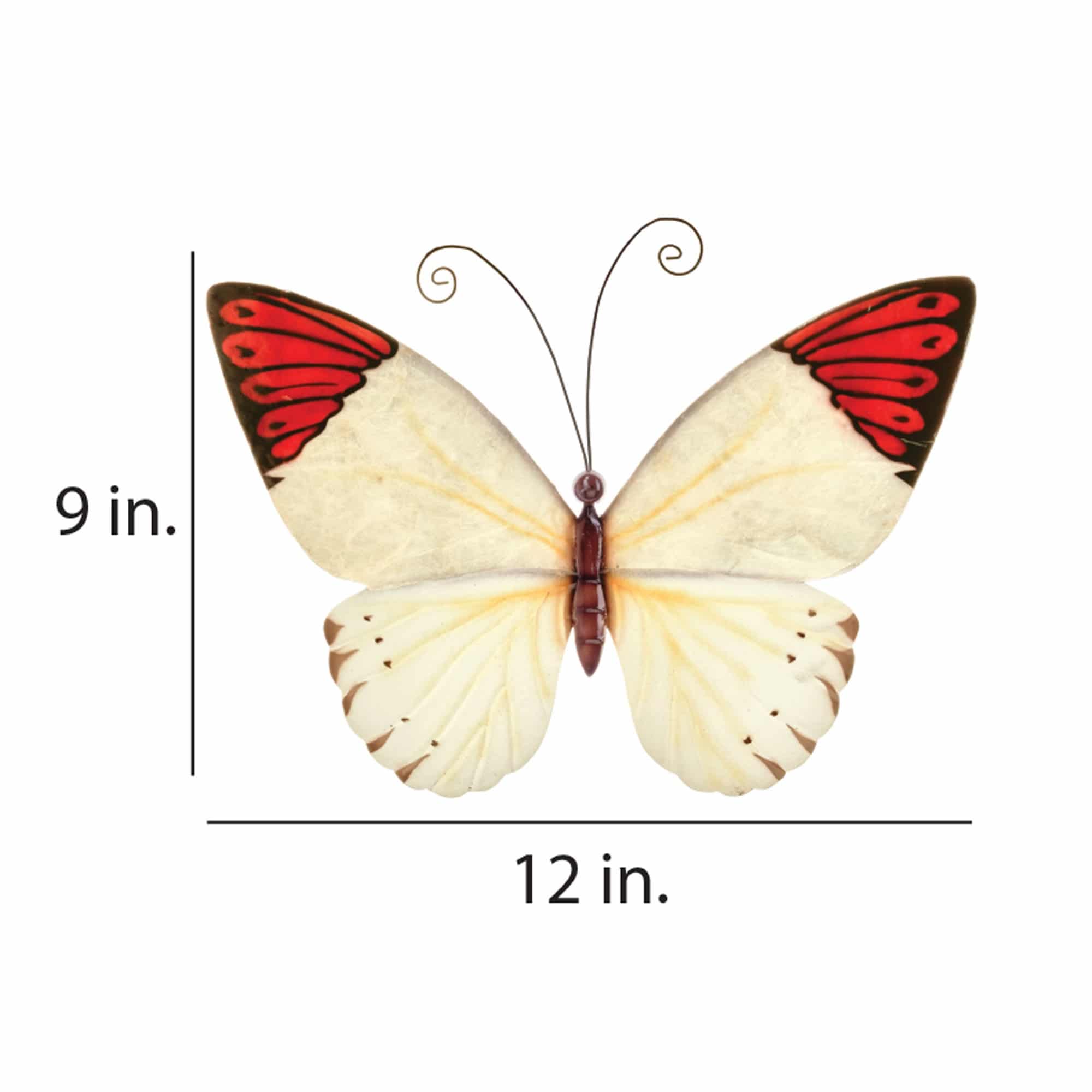
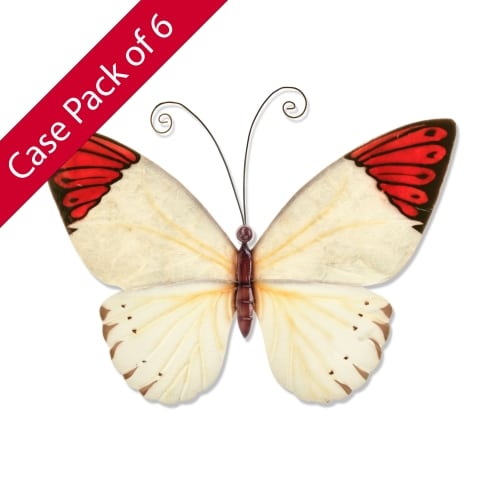 Case of 6 Starting with a base color of pearl white, the artist uses different techniques and splashes of color to craft a distinctive piece. The upper wings are created using capiz oyster shell, left natural to bring in different natural hues. The red base color is accented using brown feathering patterns. The lower portion of the wing is made of tin, textured to highlight the lines that stem from the body of the butterfly. The basic frame of the butterfly is created using tin, which is powder-coated with a black finish and makes this piece safe to use outdoors. The edges of the frame are reinforced using thicker tin wire. The front of this piece is adorned in areas with capiz shell, an oyster native to the Philippines, before being hand-painted and sealed with a water-based sealant. The primary purpose of this oyster to provide a source of food, however, the shell is a sustainable by-product that can be used for decoration. The capiz shell subtly replicates the reflective qualities of butterflies in nature. The entire piece is lightweight and has an eyelet in the back allowing it to be hung using a finishing nail, command strip, or a push pin. Due to it being a natural material, the organic colors of capiz come through as tans and browns underneath the paint.
Case of 6 Starting with a base color of pearl white, the artist uses different techniques and splashes of color to craft a distinctive piece. The upper wings are created using capiz oyster shell, left natural to bring in different natural hues. The red base color is accented using brown feathering patterns. The lower portion of the wing is made of tin, textured to highlight the lines that stem from the body of the butterfly. The basic frame of the butterfly is created using tin, which is powder-coated with a black finish and makes this piece safe to use outdoors. The edges of the frame are reinforced using thicker tin wire. The front of this piece is adorned in areas with capiz shell, an oyster native to the Philippines, before being hand-painted and sealed with a water-based sealant. The primary purpose of this oyster to provide a source of food, however, the shell is a sustainable by-product that can be used for decoration. The capiz shell subtly replicates the reflective qualities of butterflies in nature. The entire piece is lightweight and has an eyelet in the back allowing it to be hung using a finishing nail, command strip, or a push pin. Due to it being a natural material, the organic colors of capiz come through as tans and browns underneath the paint. -

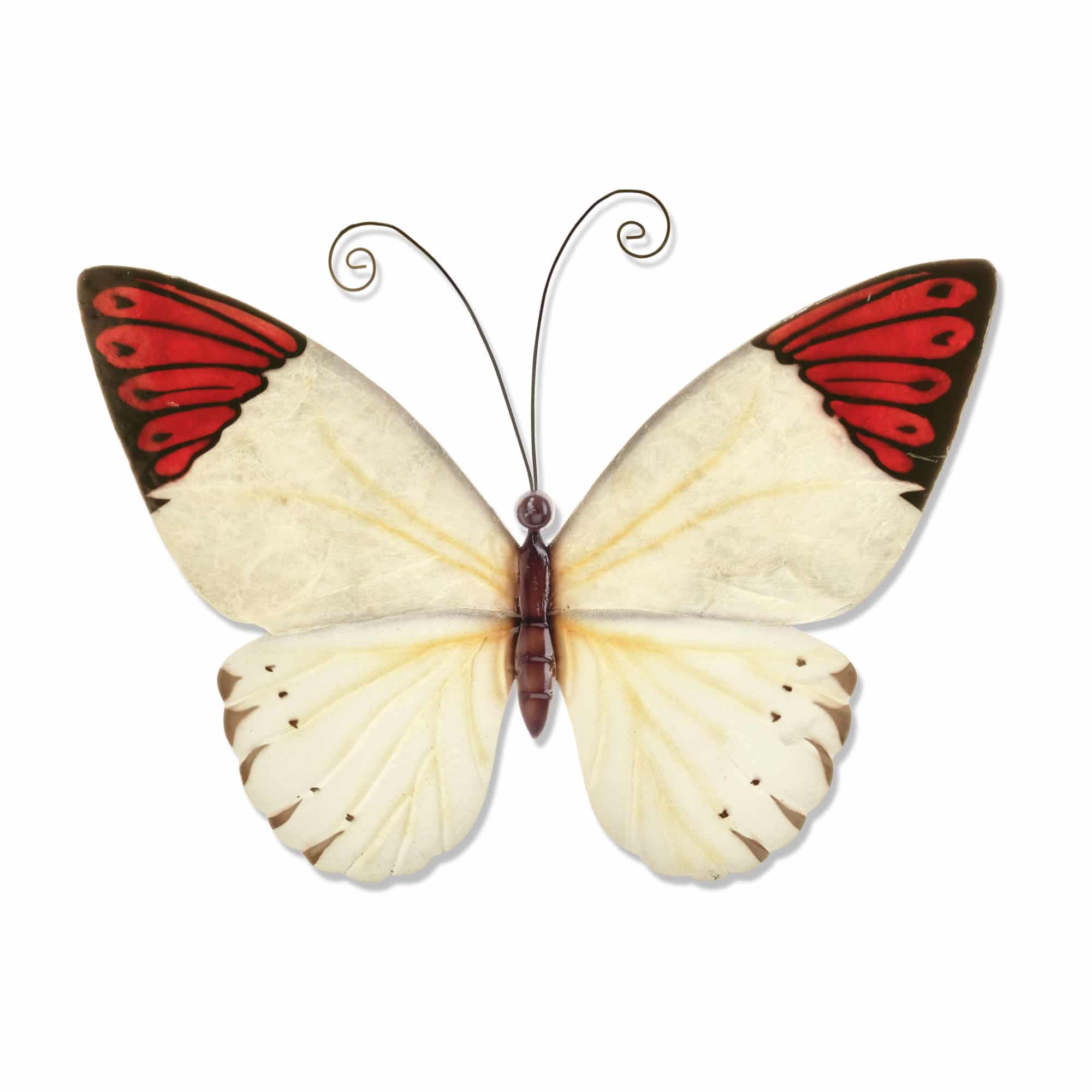 Starting with a base color of pearl white, the artist uses different techniques and splashes of color to craft a distinctive piece. The upper wings are created using capiz oyster shell, left natural to bring in different natural hues. The red base color is accented using brown feathering patterns. The lower portion of the wing is made of tin, textured to highlight the lines that stem from the body of the butterfly. The basic frame of the butterfly is created using tin, which is powder-coated with a black finish and makes this piece safe to use outdoors. The edges of the frame are reinforced using thicker tin wire. The front of this piece is adorned in areas with capiz shell, an oyster native to the Philippines, before being hand-painted and sealed with a water-based sealant. The primary purpose of this oyster to provide a source of food, however, the shell is a sustainable by-product that can be used for decoration. The capiz shell subtly replicates the reflective qualities of butterflies in nature. The entire piece is lightweight and has an eyelet in the back allowing it to be hung using a finishing nail, command strip, or a push pin. Due to it being a natural material, the organic colors of capiz come through as tans and browns underneath the paint.
Starting with a base color of pearl white, the artist uses different techniques and splashes of color to craft a distinctive piece. The upper wings are created using capiz oyster shell, left natural to bring in different natural hues. The red base color is accented using brown feathering patterns. The lower portion of the wing is made of tin, textured to highlight the lines that stem from the body of the butterfly. The basic frame of the butterfly is created using tin, which is powder-coated with a black finish and makes this piece safe to use outdoors. The edges of the frame are reinforced using thicker tin wire. The front of this piece is adorned in areas with capiz shell, an oyster native to the Philippines, before being hand-painted and sealed with a water-based sealant. The primary purpose of this oyster to provide a source of food, however, the shell is a sustainable by-product that can be used for decoration. The capiz shell subtly replicates the reflective qualities of butterflies in nature. The entire piece is lightweight and has an eyelet in the back allowing it to be hung using a finishing nail, command strip, or a push pin. Due to it being a natural material, the organic colors of capiz come through as tans and browns underneath the paint. -
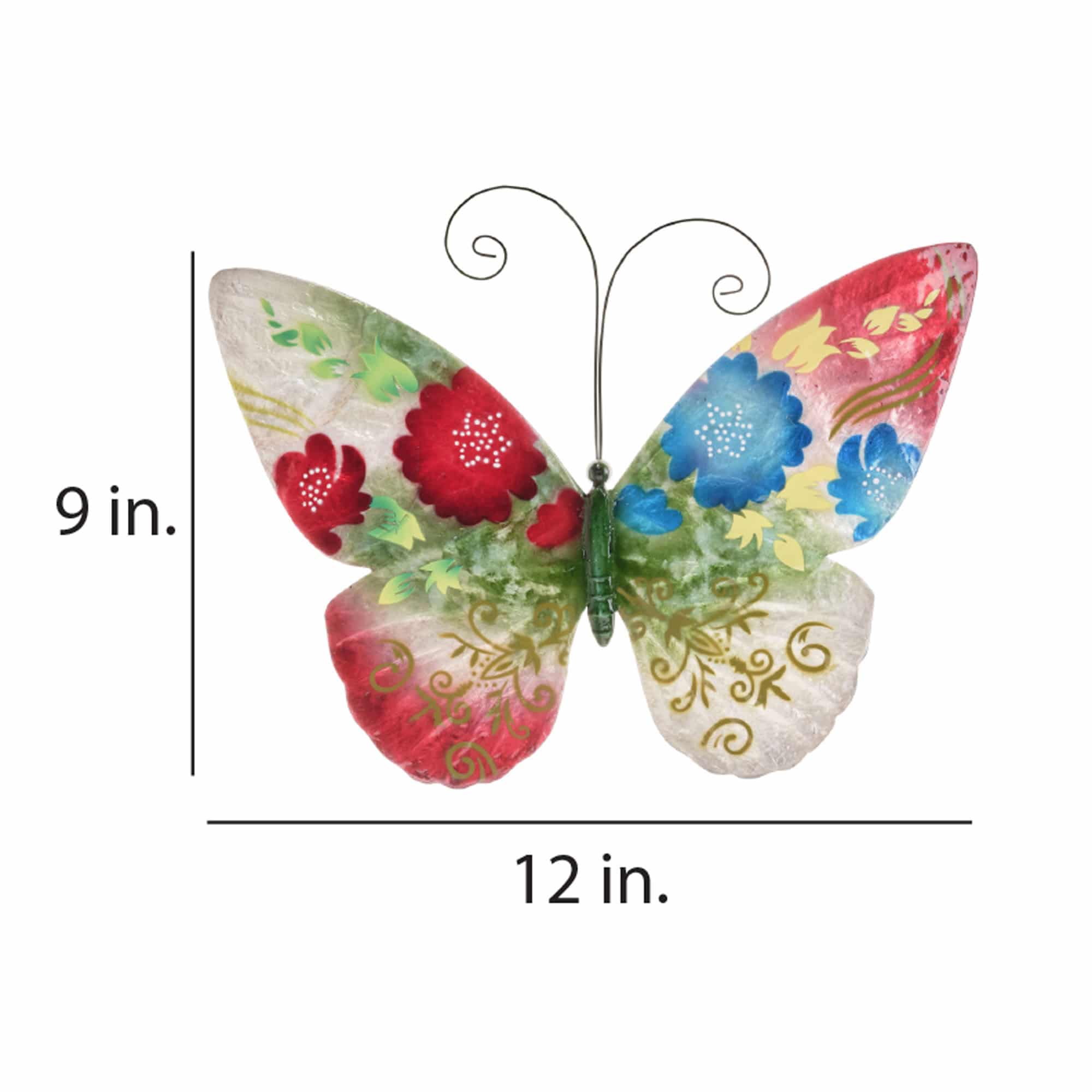
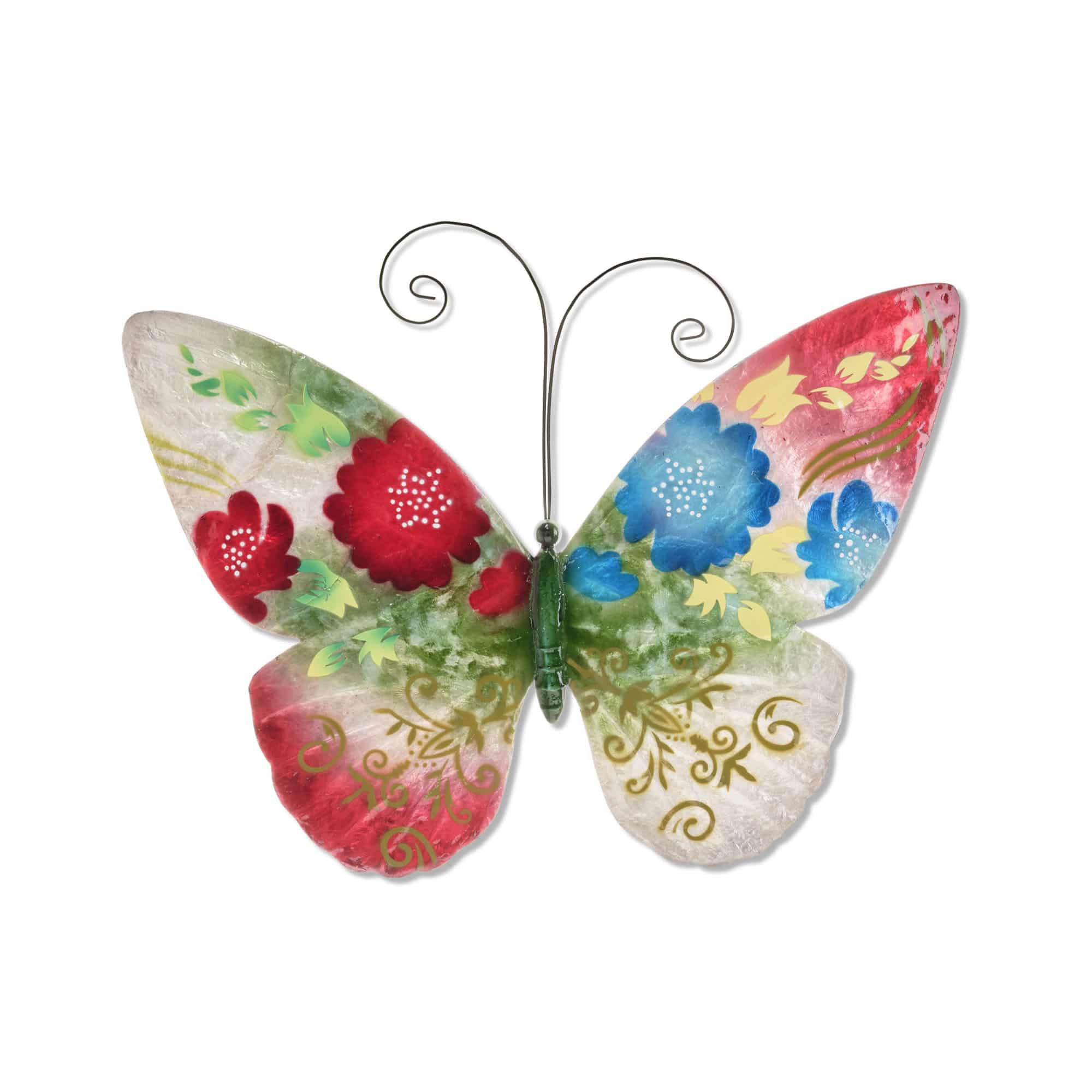
With colorful rising flowers, this butterfly represents spring rising to overtake winter's cold. The bold tones will provide strong accent to any space. A mix of color and designs painted on the wings add depth and dimension.
The basic frame of the butterfly is created using tin, which is powder-coated with a black finish and makes this piece safe to use outdoors. The edges of the frame are reinforced using thicker tin wire. The front of this piece is adorned in areas with capiz shell, an oyster native to the Philippines, before being hand-painted and sealed with a water-based sealant. The primary purpose of this oyster to provide a source of food, however, the shell is a sustainable by-product that can be used for decoration. The capiz shell subtly replicates the reflective qualities of butterflies in nature. The entire piece is lightweight and has an eyelet in the back allowing it to be hung using a finishing nail, command strip, or a push pin. Due to it being a natural material, the organic colors of capiz come through as tans and browns underneath the paint.
-


Classically painted roses adorn this set of three butterflies. The traditional pattern brings the garden indoors. Painted on mother of pearl oyster shells, the vibrant roses pop, adding color and charm.
The basic frame of the butterfly is created using tin, which is powder-coated with a black finish and makes this piece safe to use outdoors. The edges of the frame are reinforced using thicker tin wire. The front of this piece is adorned in areas with capiz shell, an oyster native to the Philippines, before being hand-painted and sealed with a water-based sealant. The primary purpose of this oyster to provide a source of food, however, the shell is a sustainable by-product that can be used for decoration. The capiz shell subtly replicates the reflective qualities of butterflies in nature. The entire piece is lightweight and has an eyelet in the back allowing it to be hung using a finishing nail, command strip, or a push pin. Due to it being a natural material, the organic colors of capiz come through as tans and browns underneath the paint.
-
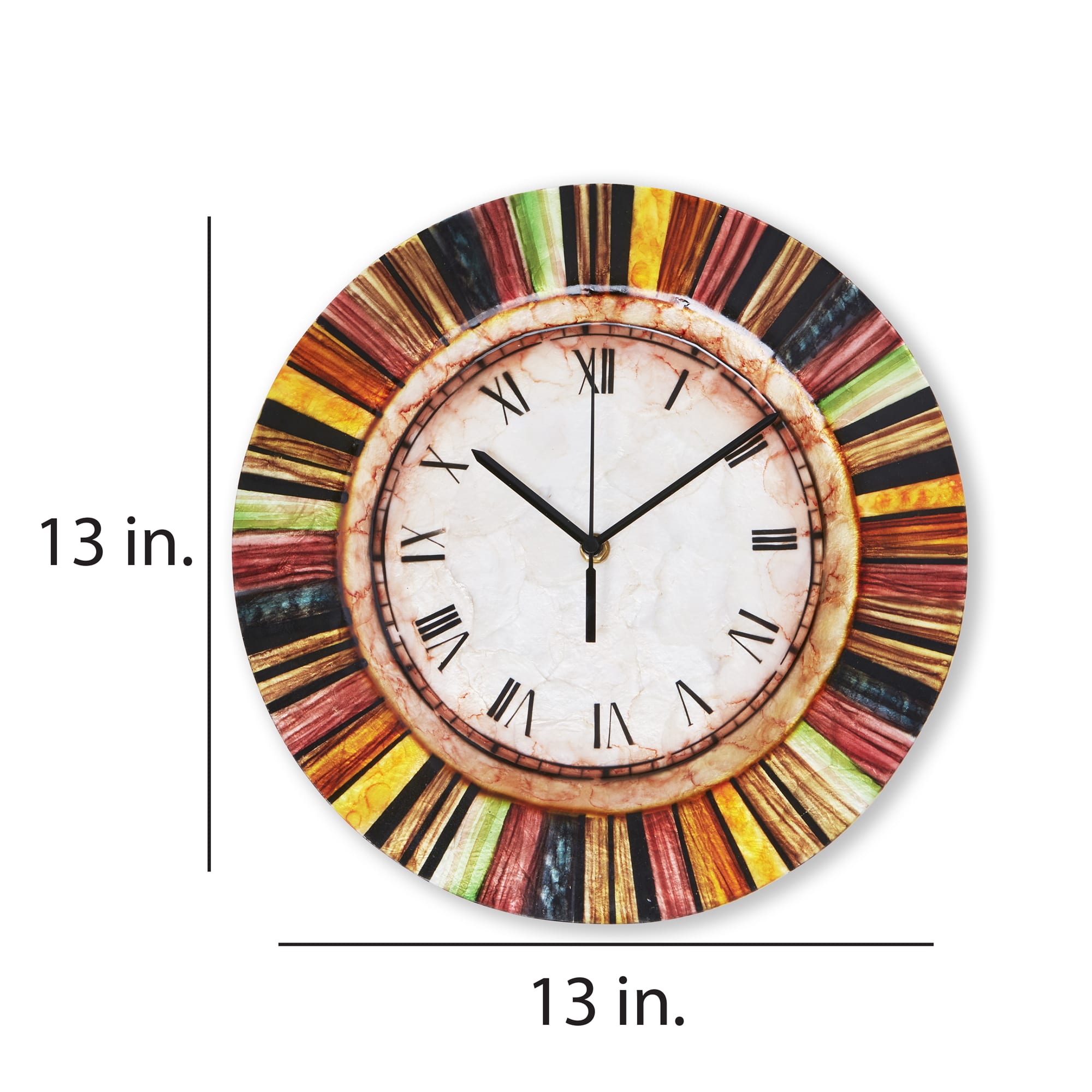
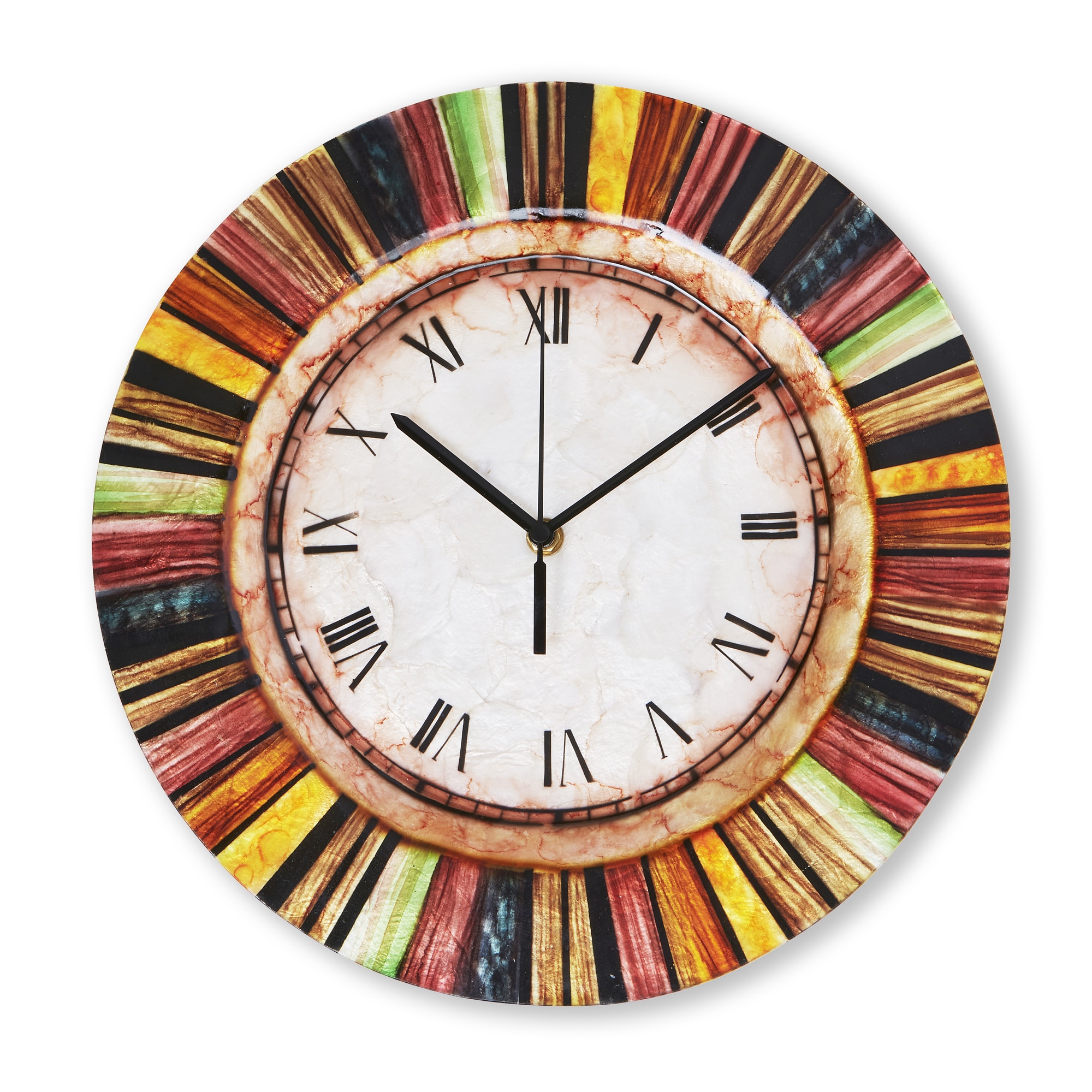 The frame of this clock is made with solid capiz oyster shell, compressed into shape.The artist calls attention to the uniqueness of each shell in the center with a high-gloss finish. Bold, roman numerals stand in contrast to the shell within the clock face. Color blocks adorn the outer rim of the clock in muted tones. The roman numerals combined with the color palette are strongly influenced from Tuscan design. Capiz is an oyster shell and the primary purpose of the oyster is as a source of food. However, the by-product, the shell, can be used for decoration. The clock is created by compressing capiz shell together and forming it into shape. The final result is a light-weight, plate that feels similar to plastic. Due to it being a natural material, the natural colors of the capiz may come through as tans and browns underneath the hand-painted surface.
The frame of this clock is made with solid capiz oyster shell, compressed into shape.The artist calls attention to the uniqueness of each shell in the center with a high-gloss finish. Bold, roman numerals stand in contrast to the shell within the clock face. Color blocks adorn the outer rim of the clock in muted tones. The roman numerals combined with the color palette are strongly influenced from Tuscan design. Capiz is an oyster shell and the primary purpose of the oyster is as a source of food. However, the by-product, the shell, can be used for decoration. The clock is created by compressing capiz shell together and forming it into shape. The final result is a light-weight, plate that feels similar to plastic. Due to it being a natural material, the natural colors of the capiz may come through as tans and browns underneath the hand-painted surface. -
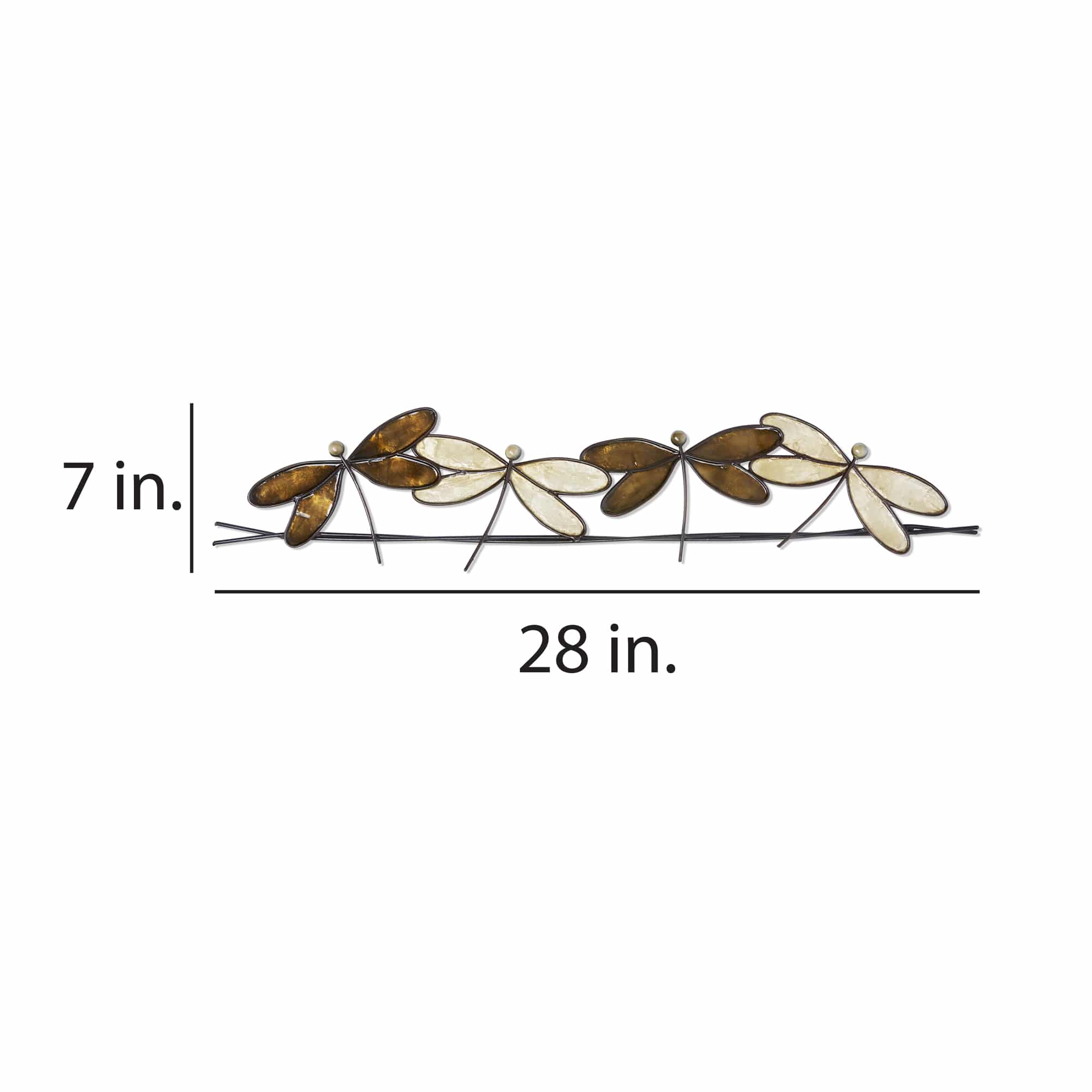
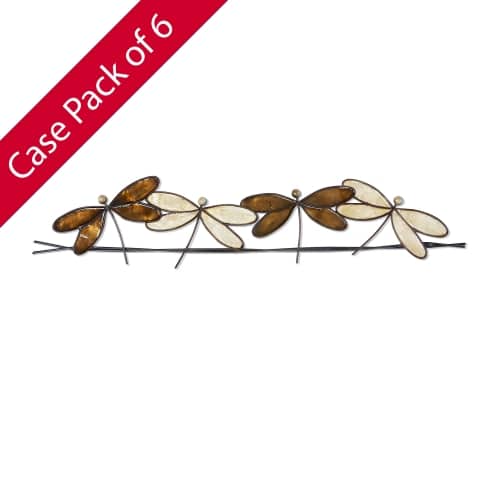 Case of 6
Case of 6Four dragonflies are taking a mid-day break from fluttering and their characteristically unpredictable flight patterns around the lake. The slender, metal body of each dragonfly connects to colorful, capiz-shell wings, which catches light and adds shine. Each wing is framed using sturdy wrought iron and reinforced with a metal backing.
The basic frame of the dragonfly is created using tin, which is powder-coated with a black finish and makes this piece safe to use outdoors. The edges of the frame are reinforced using thicker tin wire. The front of this piece is adorned in areas with capiz shell, an oyster native to the Philippines, before being hand-painted and sealed with a water-based sealant. The primary purpose of this oyster to provide a source of food, however, the shell is a sustainable by-product that can be used for decoration. The capiz shell subtly replicates the reflective qualities of dragonflies in nature. The entire piece is lightweight and has an eyelet in the back allowing it to be hung using a finishing nail, command strip, or a push pin. Due to it being a natural material, the organic colors of capiz come through as tans and browns underneath the paint.
-

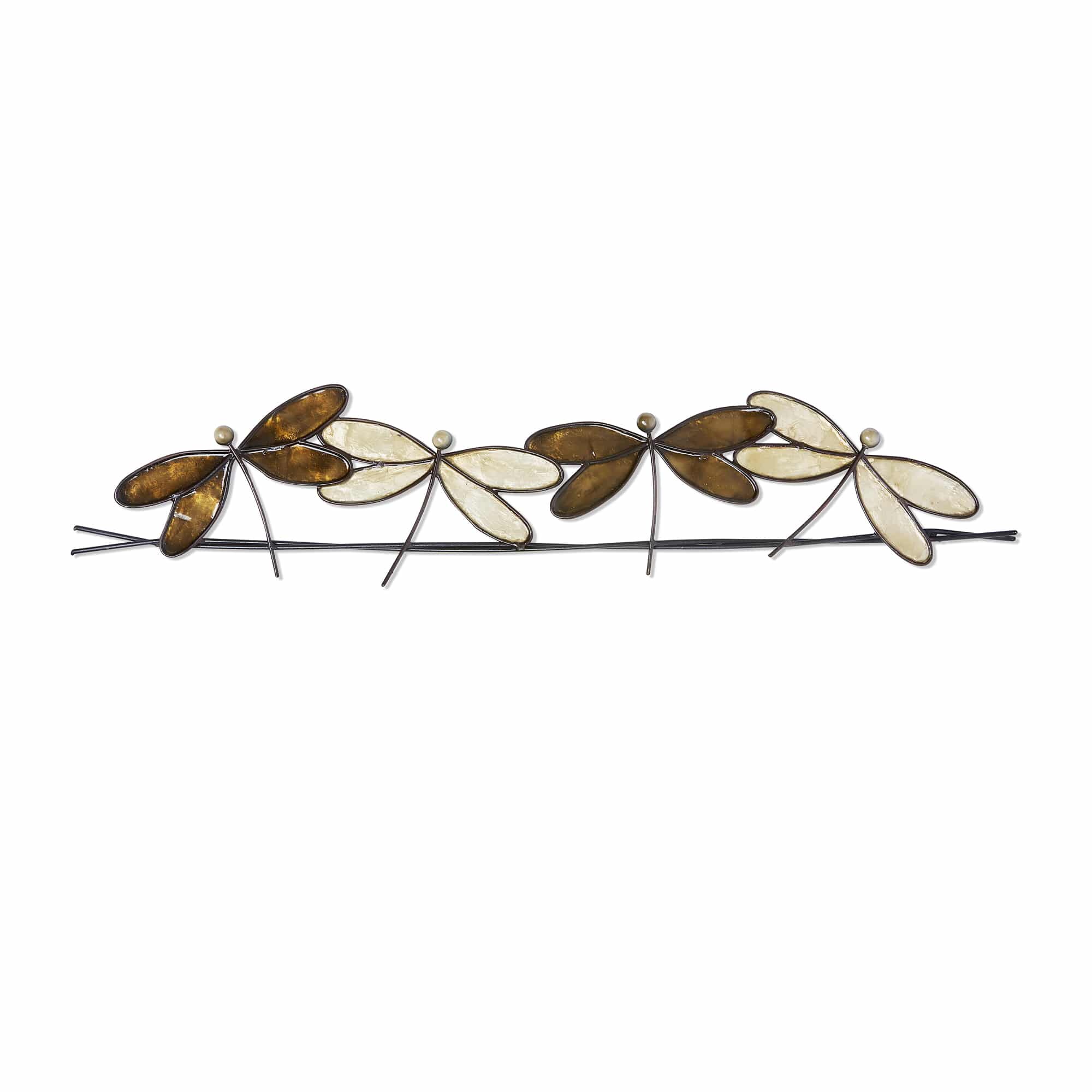
Four dragonflies are taking a mid-day break from fluttering and their characteristically unpredictable flight patterns around the lake. The slender, metal body of each dragonfly connects to colorful, capiz-shell wings, which catches light and adds shine. Each wing is framed using sturdy wrought iron and reinforced with a metal backing.
The basic frame of the dragonfly is created using tin, which is powder-coated with a black finish and makes this piece safe to use outdoors. The edges of the frame are reinforced using thicker tin wire. The front of this piece is adorned in areas with capiz shell, an oyster native to the Philippines, before being hand-painted and sealed with a water-based sealant. The primary purpose of this oyster to provide a source of food, however, the shell is a sustainable by-product that can be used for decoration. The capiz shell subtly replicates the reflective qualities of dragonflies in nature. The entire piece is lightweight and has an eyelet in the back allowing it to be hung using a finishing nail, command strip, or a push pin. Due to it being a natural material, the organic colors of capiz come through as tans and browns underneath the paint.
-


Reflecting the natural greens and blues of the nearly translucent dragonfly wings, the artist uses a base of capiz shell on the lower wings to embody the almost ephemeral structure. The upper wings feature a hand etched pattern mimicking the texture of a dragonfly�s organic wing structure. The blues and greens continue down the body creating a lively and colorful piece.
The basic frame of the dragonfly is created using tin, which is powder-coated with a black finish and makes this piece safe to use outdoors. The edges of the frame are reinforced using thicker tin wire. The front of this piece is adorned in areas with capiz shell, an oyster native to the Philippines, before being hand-painted and sealed with a water-based sealant. The primary purpose of this oyster to provide a source of food, however, the shell is a sustainable by-product that can be used for decoration. The capiz shell subtly replicates the reflective qualities of dragonflies in nature. The entire piece is lightweight and has an eyelet in the back allowing it to be hung using a finishing nail, command strip, or a push pin. Due to it being a natural material, the organic colors of capiz come through as tans and browns underneath the paint.
-
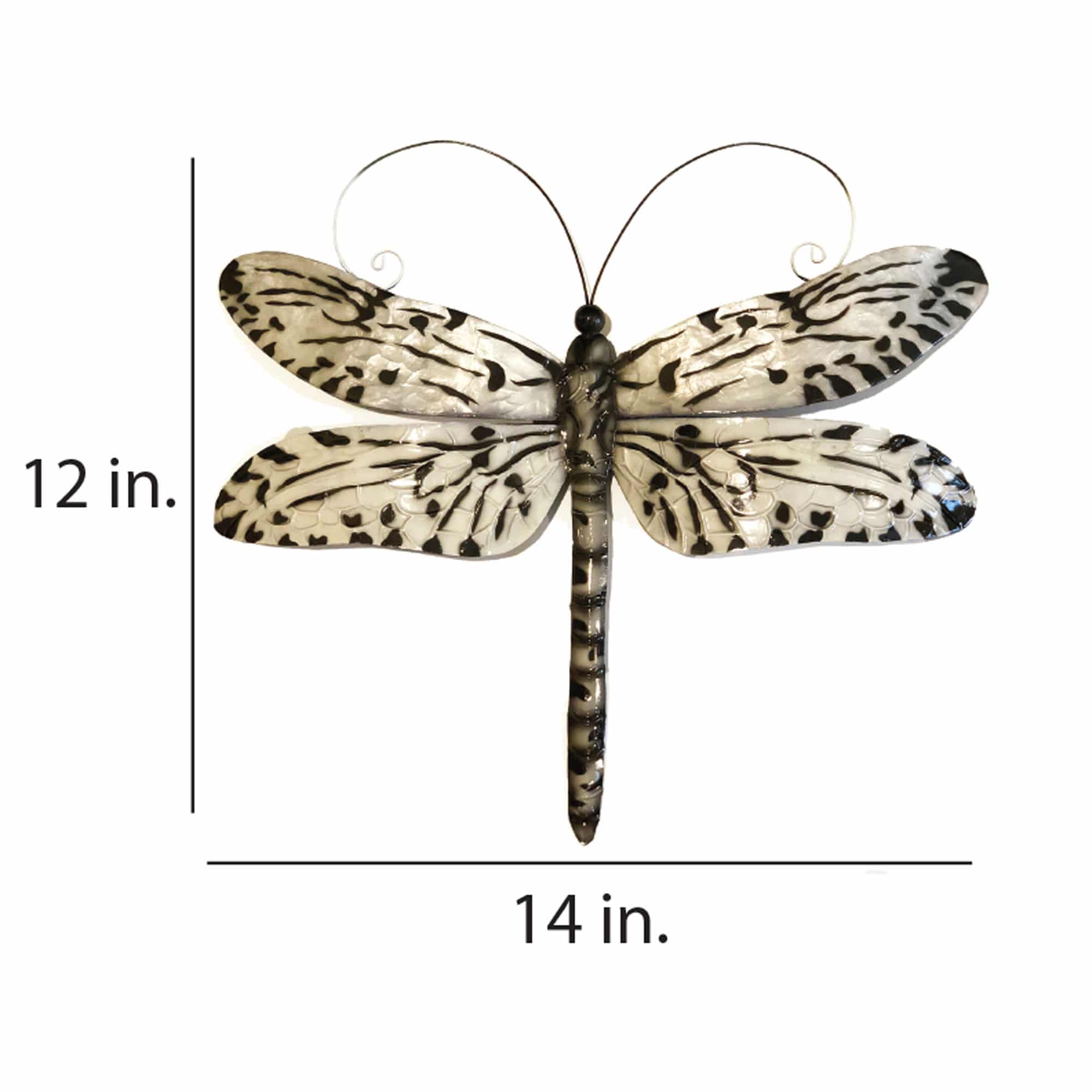
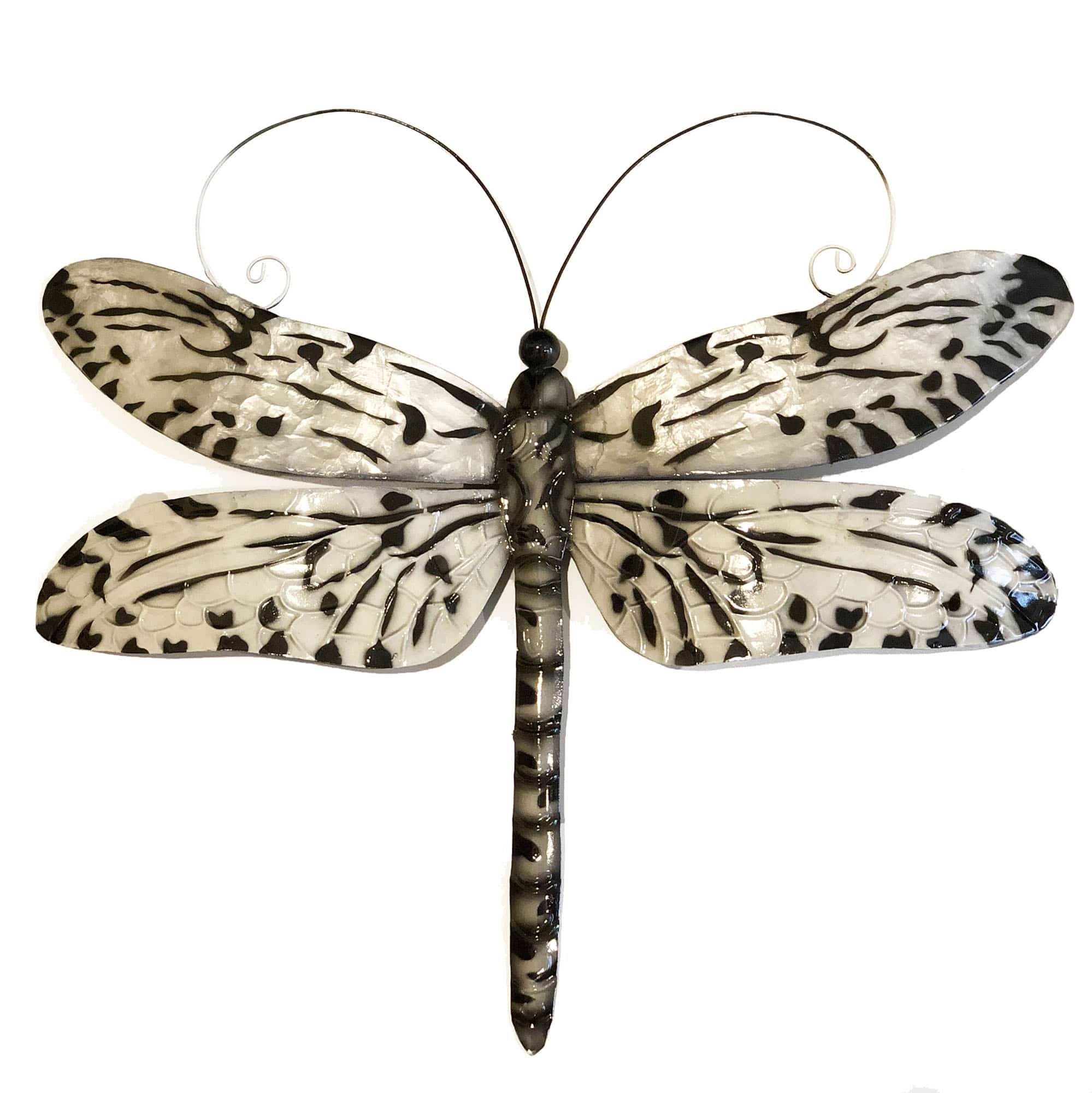
Angelic and graceful, this dragonfly is distinctive and regal. The wings of this piece are rather large and stately, particularly when this beauty flies on the breeze from flower to flower. The artist brings this to life by crafting the body smaller compared to the wings. The upper wings are adorned with capiz shell, giving it the translucent color seen in the natural dragonfly. The lower wings are constructed from tin and the colors help accentuate the vein structures. The combination of the two will add both color and structure to your wall and your room.
The basic frame of the dragonfly is created using tin, which is powder-coated with a black finish and makes this piece safe to use outdoors. The edges of the frame are reinforced using thicker tin wire. The front of this piece is adorned in areas with capiz shell, an oyster native to the Philippines, before being hand-painted and sealed with a water-based sealant. The primary purpose of this oyster to provide a source of food, however, the shell is a sustainable by-product that can be used for decoration. The capiz shell subtly replicates the reflective qualities of dragonflies in nature. The entire piece is lightweight and has an eyelet in the back allowing it to be hung using a finishing nail, command strip, or a push pin. Due to it being a natural material, the organic colors of capiz come through as tans and browns underneath the paint.
-
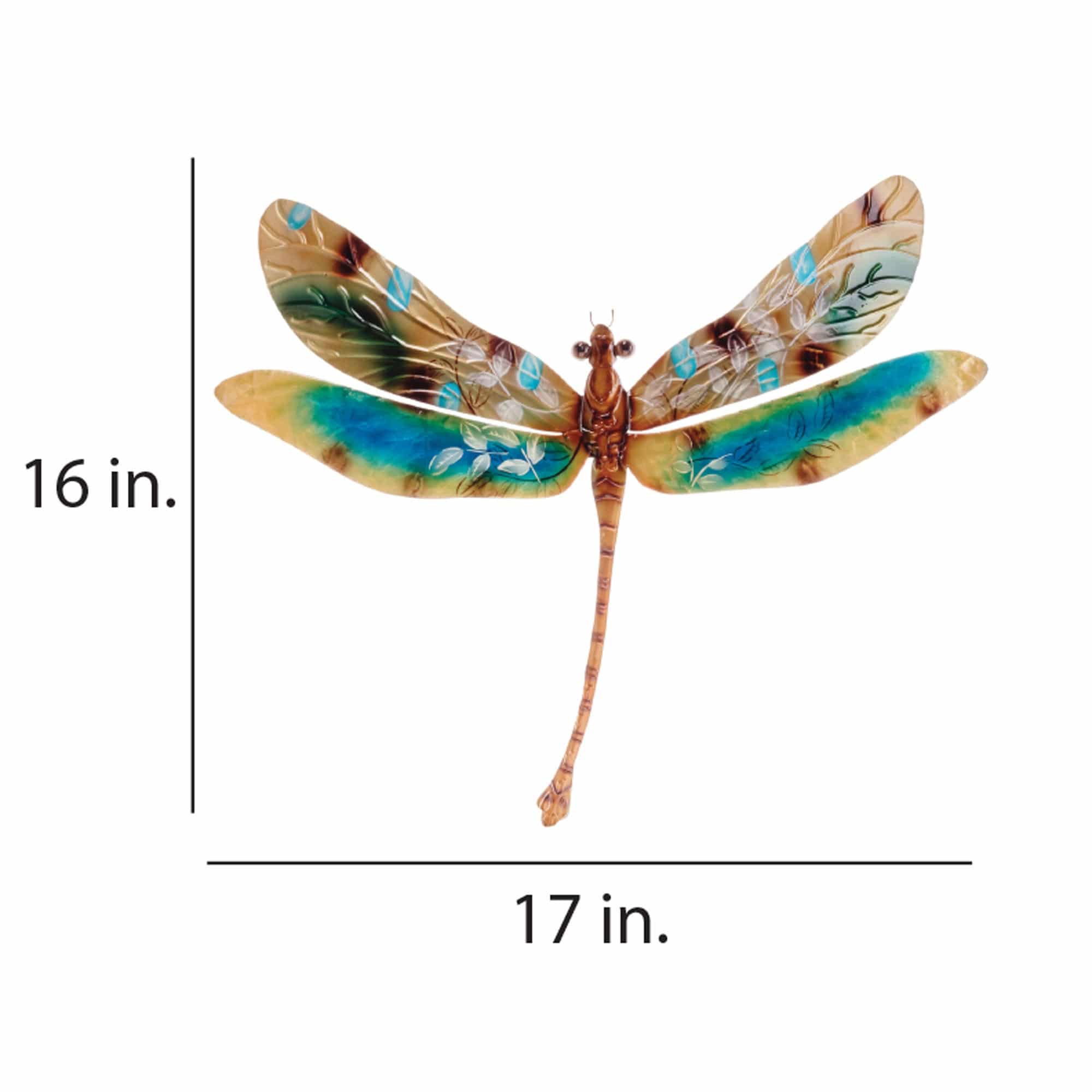
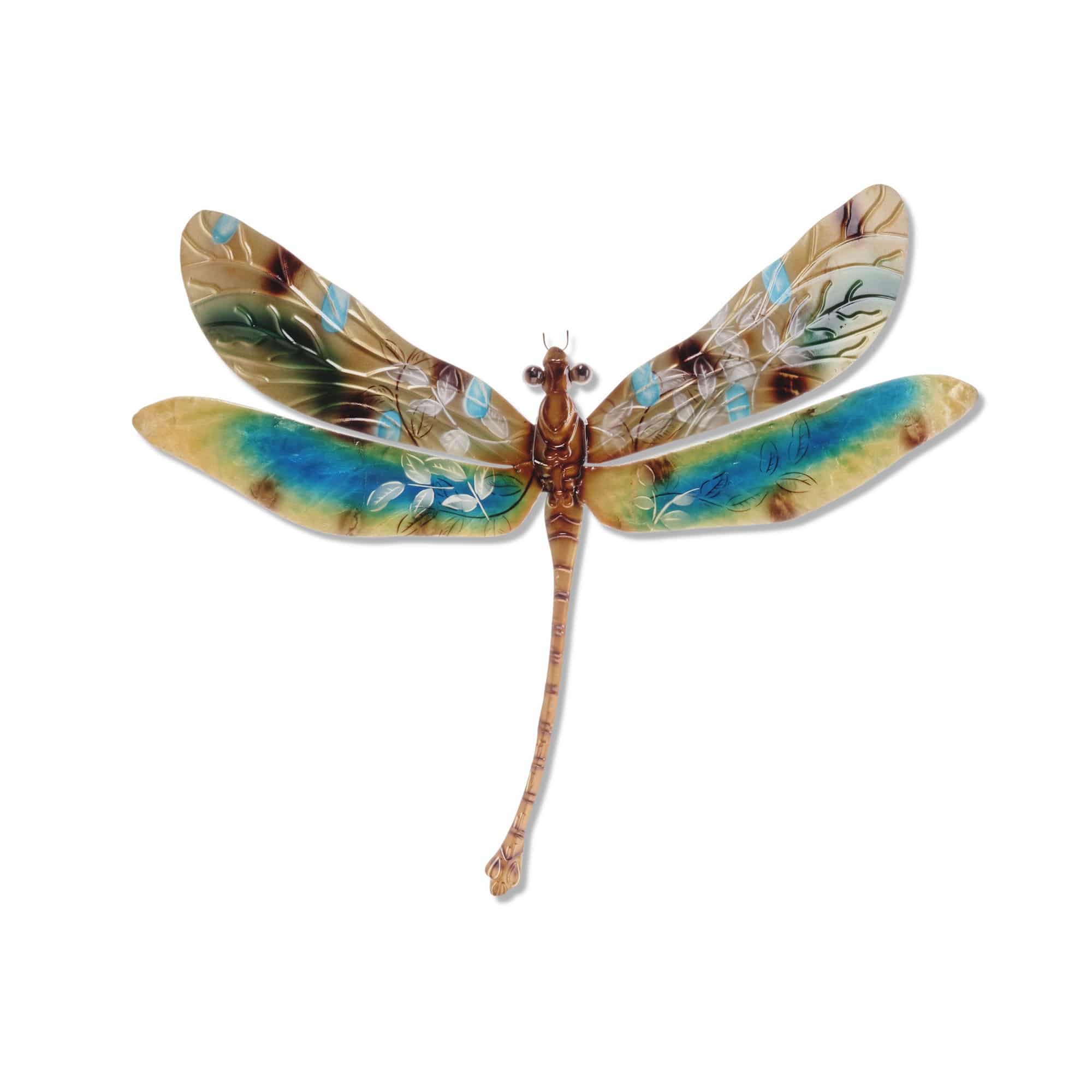
The color pallet of this dragonfly is true to form with its aqua, gold, and brown hues. The artist adds leafy structure to the dragonfly�s to the upper wing while providing shimmer and geomatics design with capiz shell in the lower half. Additional detail is added with hand painted, white foliage that starts on the lower wing and travels to the upper wing, reflecting the dragonfly�s natural habitat.
The basic frame of the dragonfly is created using tin, which is powder-coated with a black finish and makes this piece safe to use outdoors. The edges of the frame are reinforced using thicker tin wire. The front of this piece is adorned in areas with capiz shell, an oyster native to the Philippines, before being hand-painted and sealed with a water-based sealant. The primary purpose of this oyster to provide a source of food, however, the shell is a sustainable by-product that can be used for decoration. The capiz shell subtly replicates the reflective qualities of dragonflies in nature. The entire piece is lightweight and has an eyelet in the back allowing it to be hung using a finishing nail, command strip, or a push pin. Due to it being a natural material, the organic colors of capiz come through as tans and browns underneath the paint.
-
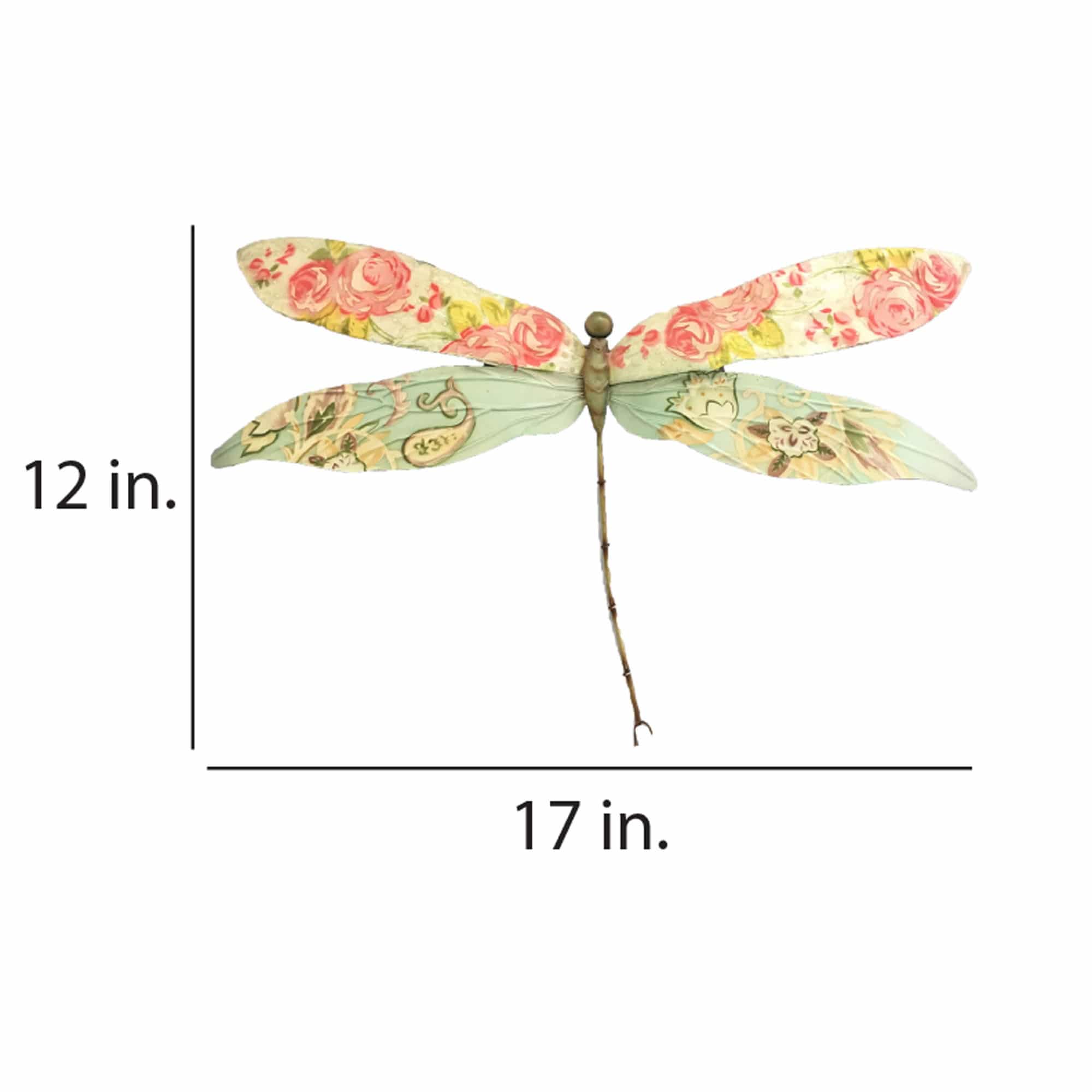
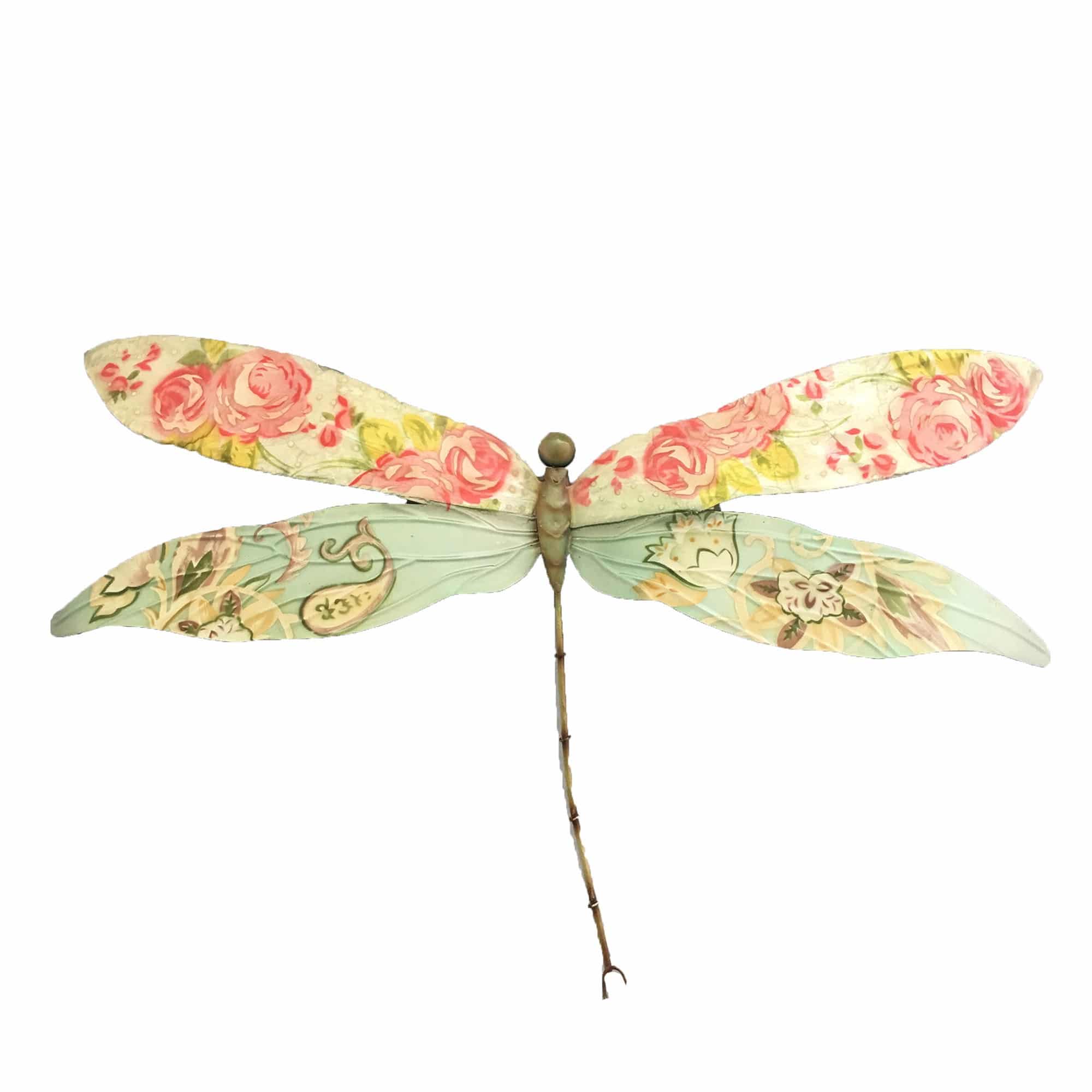
The color pallet and the design gives this dragonfly a strong vintage appeal. The upper wing is crafted using capiz oyster shell. The artist then delicately paints a bouquet of pink roses. Strong lines of the dragonfly are etched into the lower wing. A pattern of flowers are designs are carefully drawn on top of the base color of turquoise.
The basic frame of the dragonfly is created using tin, which is powder-coated with a black finish and makes this piece safe to use outdoors. The edges of the frame are reinforced using thicker tin wire. The front of this piece is adorned in areas with capiz shell, an oyster native to the Philippines, before being hand-painted and sealed with a water-based sealant. The primary purpose of this oyster to provide a source of food, however, the shell is a sustainable by-product that can be used for decoration. The capiz shell subtly replicates the reflective qualities of dragonflies in nature. The entire piece is lightweight and has an eyelet in the back allowing it to be hung using a finishing nail, command strip, or a push pin. Due to it being a natural material, the organic colors of capiz come through as tans and browns underneath the paint.
-
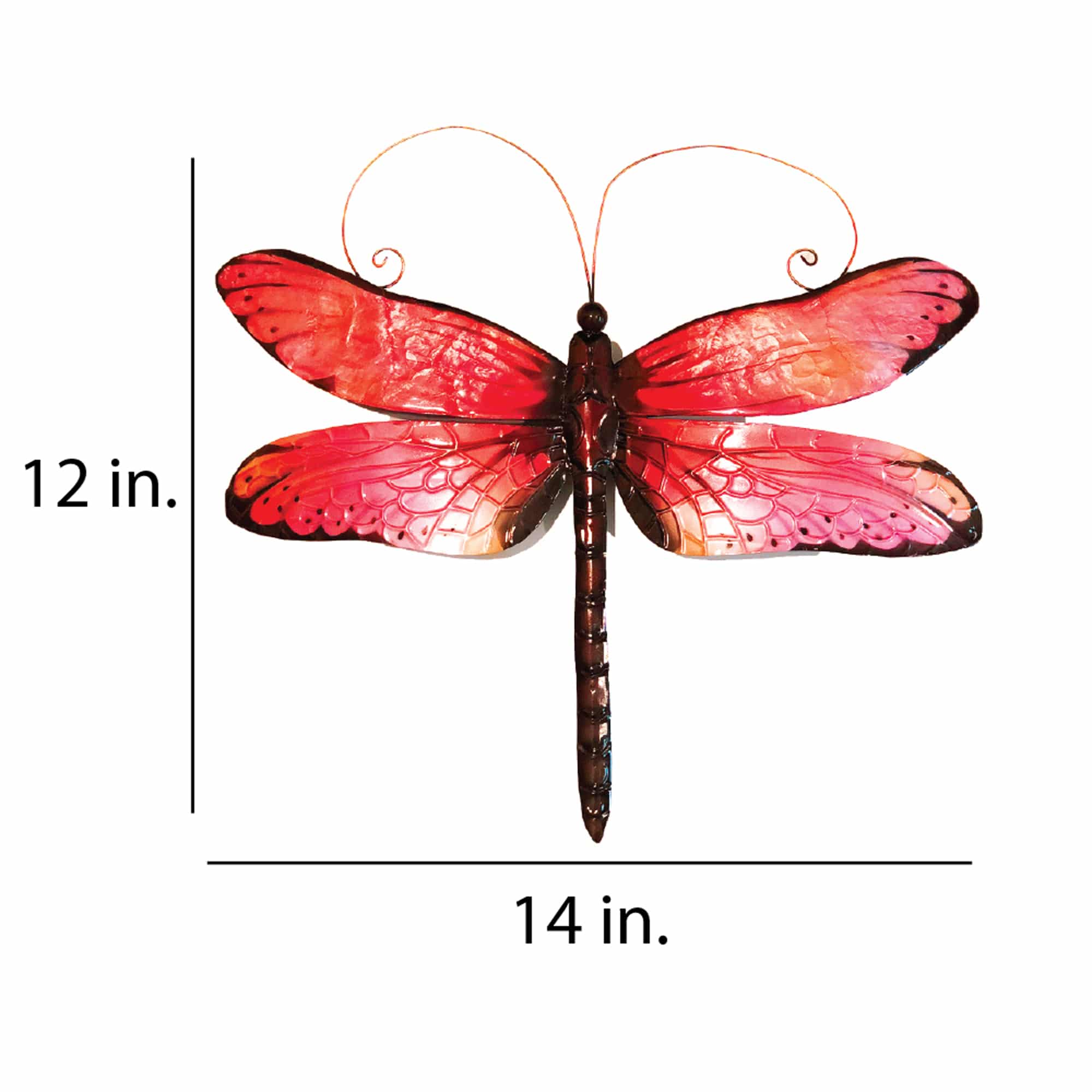
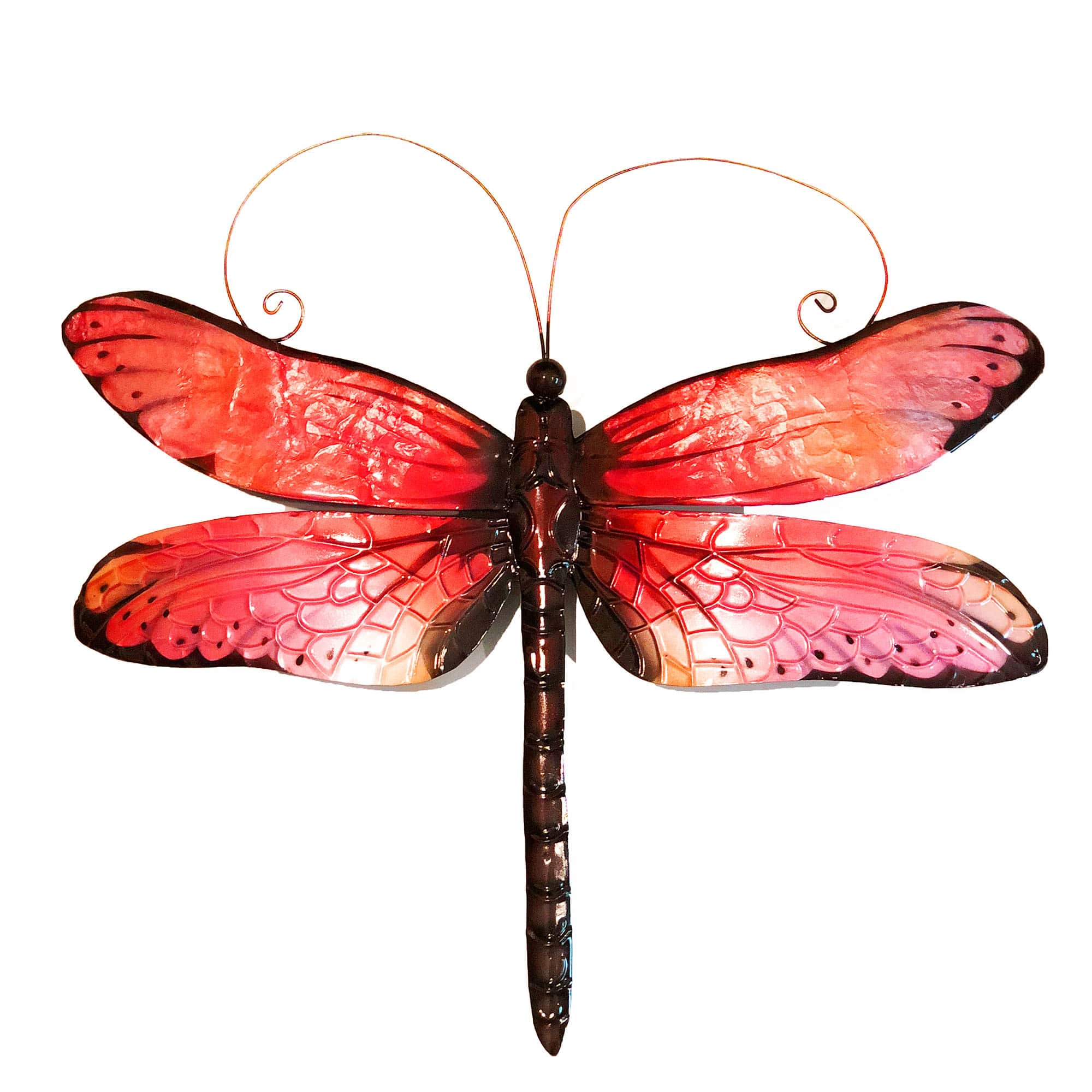
The artists truly captured the bold reds and contrasting black that this dragonfly is known for in its natural form. To enhance the illusion of transparency, the artists use capiz shell in the upper wing to reflect more light. Hand-painted, but with varying degree of hue, this butterfly will feel like the real deal on your wall, except for the size of course.
The basic frame of the dragonfly is created using tin, which is powder-coated with a black finish and makes this piece safe to use outdoors. The edges of the frame are reinforced using thicker tin wire. The front of this piece is adorned in areas with capiz shell, an oyster native to the Philippines, before being hand-painted and sealed with a water-based sealant. The primary purpose of this oyster to provide a source of food, however, the shell is a sustainable by-product that can be used for decoration. The capiz shell subtly replicates the reflective qualities of dragonflies in nature. The entire piece is lightweight and has an eyelet in the back allowing it to be hung using a finishing nail, command strip, or a push pin. Due to it being a natural material, the organic colors of capiz come through as tans and browns underneath the paint.
-


The wings of this dragonfly are rather large and stately, particularly when this beauty flies on the breeze from flower to flower. The artist brings this to life by crafting the body smaller compared to the wings. The wings are adorned with capiz shell, giving it the translucent color seen in a natural dragonfly. Veins are drawn in throughout it and accentuated on its back are bright red spots, meant to pop out.
The basic frame of the dragonfly is created using tin, which is powder-coated with a black finish and makes this piece safe to use outdoors. The edges of the frame are reinforced using thicker tin wire. The front of this piece is adorned in areas with capiz shell, an oyster native to the Philippines, before being hand-painted and sealed with a water-based sealant. The primary purpose of this oyster to provide a source of food, however, the shell is a sustainable by-product that can be used for decoration. The capiz shell subtly replicates the reflective qualities of dragonflies in nature. The entire piece is lightweight and has an eyelet in the back allowing it to be hung using a finishing nail, command strip, or a push pin. Due to it being a natural material, the organic colors of capiz come through as tans and browns underneath the paint.
-
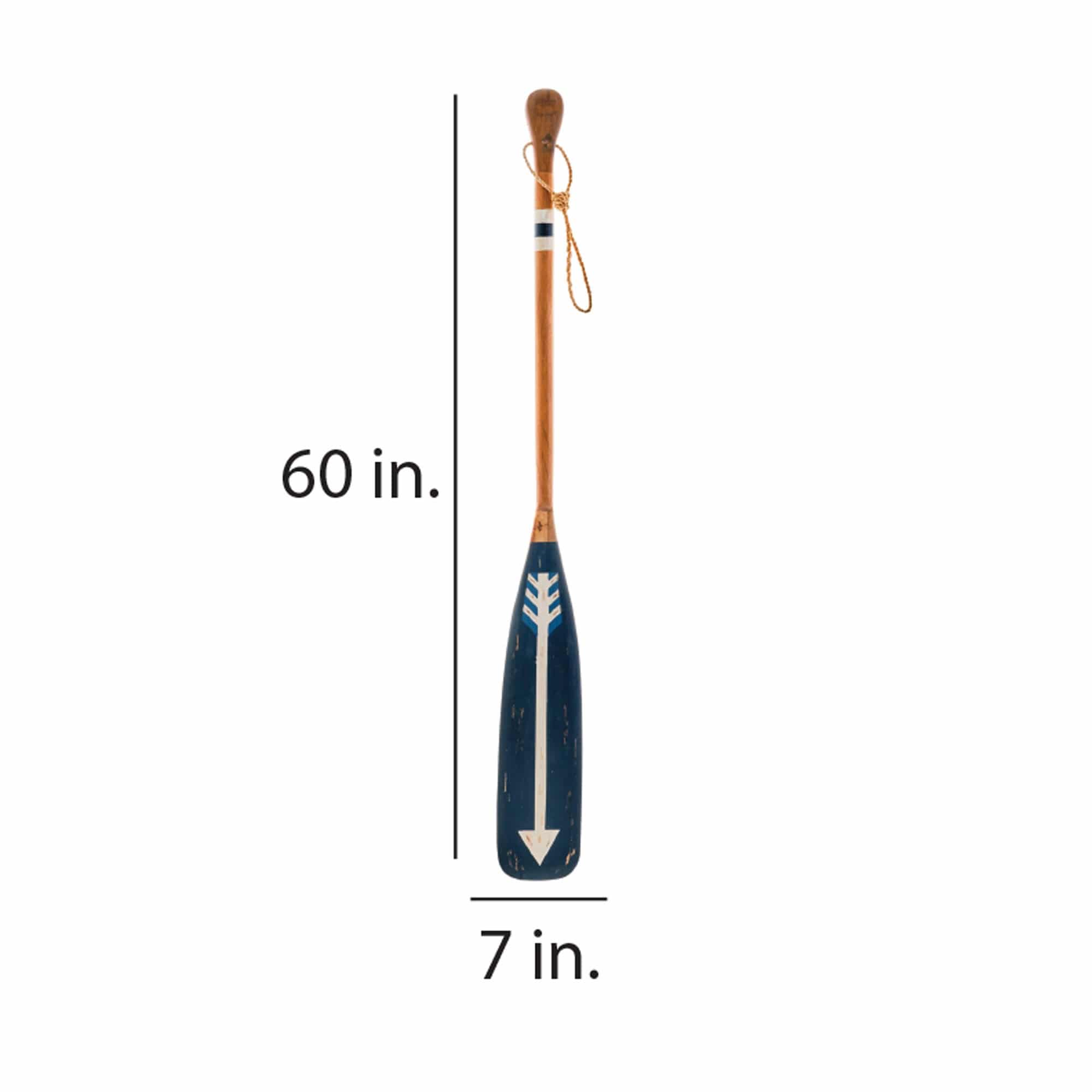
 Bring back fond memories of summer camp with this vintage style oar designed with a white arrow through the center through a blue field. The solid wood, eco-friendly piece is handmade through the honed talents of highly skilled artisans. The distressed finish is hand-painted to look aged and weathered, as if it had been used for many long warm summers. Features solid reclaimed Philippine mahogany wood construction with a distressed, hand-painted finish on one side. Includes a decorative abaca rope for added design as well as hanging purposes. This item can be hung vertically or horizontally.
Bring back fond memories of summer camp with this vintage style oar designed with a white arrow through the center through a blue field. The solid wood, eco-friendly piece is handmade through the honed talents of highly skilled artisans. The distressed finish is hand-painted to look aged and weathered, as if it had been used for many long warm summers. Features solid reclaimed Philippine mahogany wood construction with a distressed, hand-painted finish on one side. Includes a decorative abaca rope for added design as well as hanging purposes. This item can be hung vertically or horizontally. -
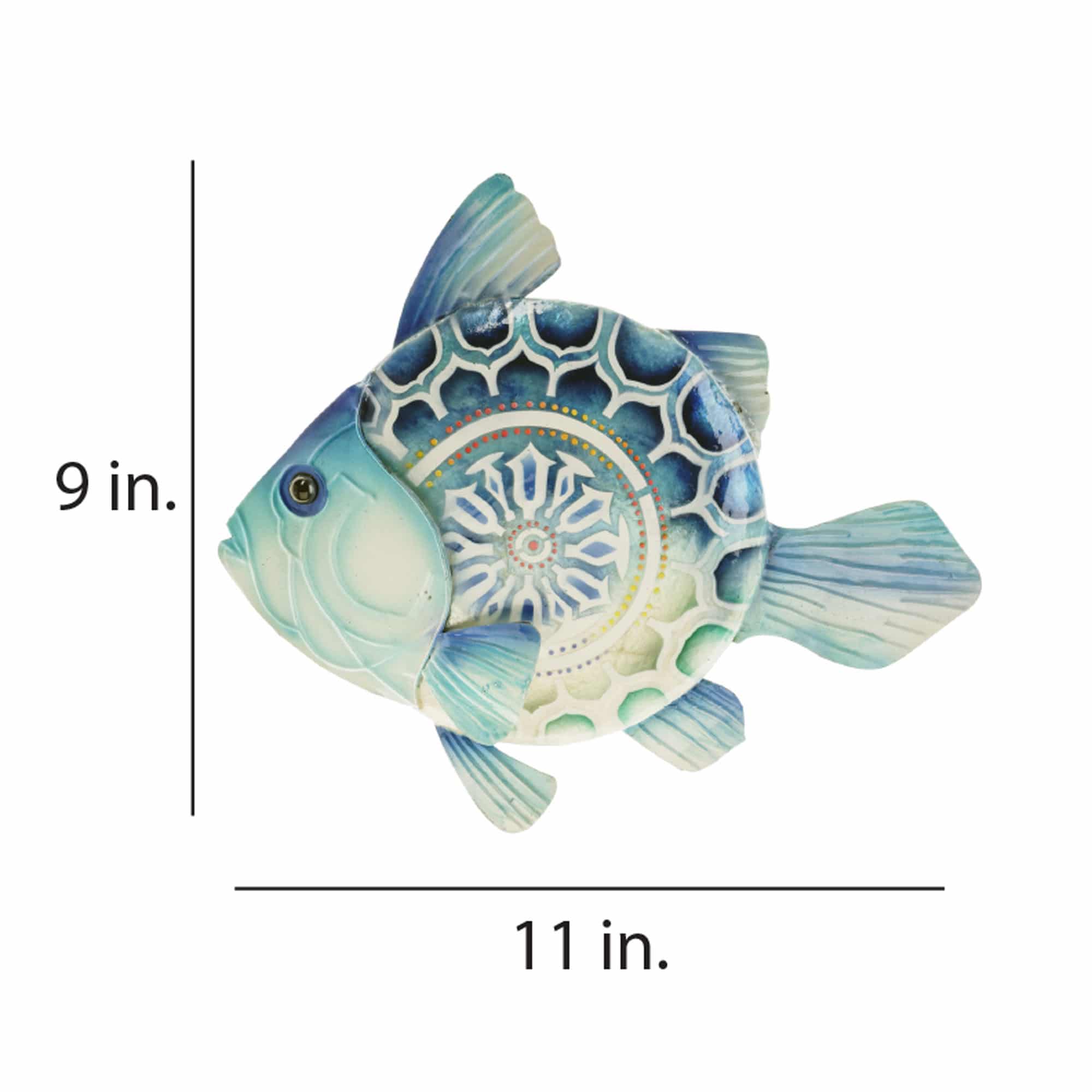
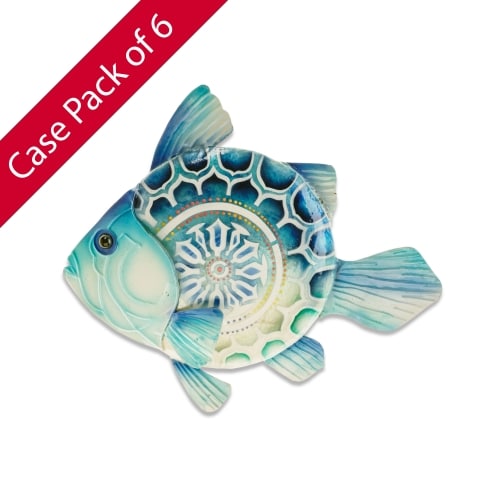 Case of 6 This fish is an artist's interpretation of the blue sea bass. The rich blue tones are common not only on the fish, but also the water within which it resides. The spiky fines and the scaly skin are also captured by the artist. The center of the fish is most interesting as it is adorned with capiz shell, which is hand-painted in wavy lines, representing the movement of the ocean as well as the fish. This piece will bring in color and design to your space and a smile to your face. The basic frame of the wall fish is created using tin, which is powder coated as a black finish. The frame is reinforced using wrought iron wire along the inner edge. Capiz is an oyster shell and the primary purpose of the oyster is as a source of food. However, the by-product, the shell, can be used for decoration. Due to it being a natural material, the natural colors of the capiz can come through as tans and browns underneath the paint.
Case of 6 This fish is an artist's interpretation of the blue sea bass. The rich blue tones are common not only on the fish, but also the water within which it resides. The spiky fines and the scaly skin are also captured by the artist. The center of the fish is most interesting as it is adorned with capiz shell, which is hand-painted in wavy lines, representing the movement of the ocean as well as the fish. This piece will bring in color and design to your space and a smile to your face. The basic frame of the wall fish is created using tin, which is powder coated as a black finish. The frame is reinforced using wrought iron wire along the inner edge. Capiz is an oyster shell and the primary purpose of the oyster is as a source of food. However, the by-product, the shell, can be used for decoration. Due to it being a natural material, the natural colors of the capiz can come through as tans and browns underneath the paint. -

 This fish is an artist's interpretation of the blue sea bass. The rich blue tones are common not only on the fish, but also the water within which it resides. The spiky fines and the scaly skin are also captured by the artist. The center of the fish is most interesting as it is adorned with capiz shell, which is hand-painted in wavy lines, representing the movement of the ocean as well as the fish. This piece will bring in color and design to your space and a smile to your face. The basic frame of the wall fish is created using tin, which is powder coated as a black finish. The frame is reinforced using wrought iron wire along the inner edge. Capiz is an oyster shell and the primary purpose of the oyster is as a source of food. However, the by-product, the shell, can be used for decoration. Due to it being a natural material, the natural colors of the capiz can come through as tans and browns underneath the paint.
This fish is an artist's interpretation of the blue sea bass. The rich blue tones are common not only on the fish, but also the water within which it resides. The spiky fines and the scaly skin are also captured by the artist. The center of the fish is most interesting as it is adorned with capiz shell, which is hand-painted in wavy lines, representing the movement of the ocean as well as the fish. This piece will bring in color and design to your space and a smile to your face. The basic frame of the wall fish is created using tin, which is powder coated as a black finish. The frame is reinforced using wrought iron wire along the inner edge. Capiz is an oyster shell and the primary purpose of the oyster is as a source of food. However, the by-product, the shell, can be used for decoration. Due to it being a natural material, the natural colors of the capiz can come through as tans and browns underneath the paint. -
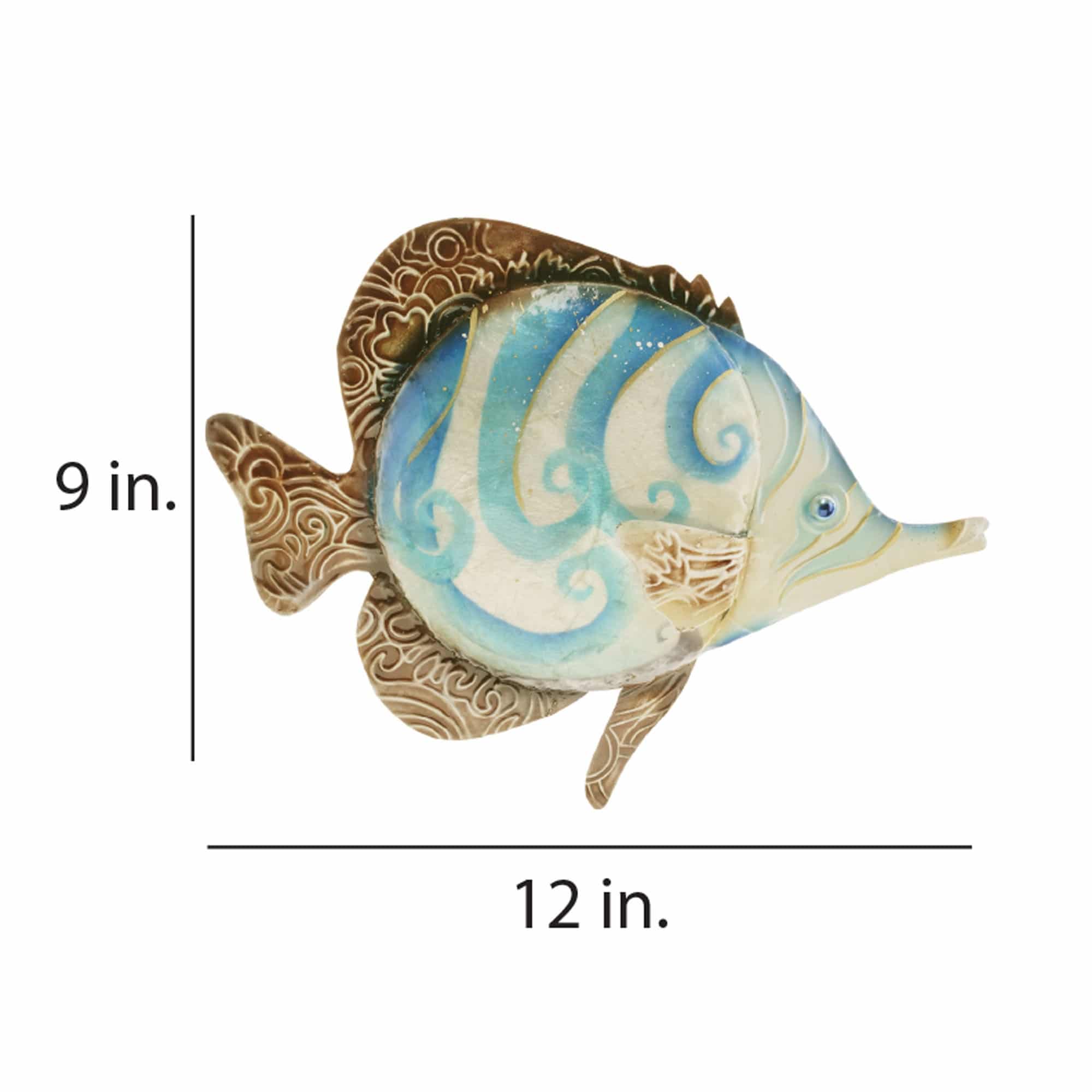
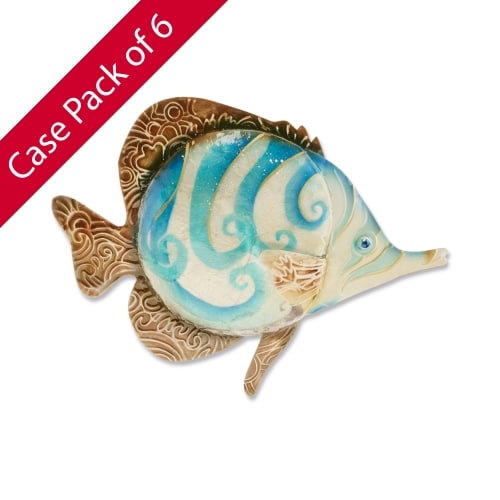 Case of 6 This fish was inspired by the Copperband Butterfly Fish. Though the name is a mouthful, the artist did capture the strips, colors, broad fins, and the beak that this fish is known for. The blue and pearl swirls contrast with its deeper bronze fins. Those fins are further enhanced with a swirled design, creating a very complex piece. The results is a piece rich in design and color. The basic frame of the wall fish is created using tin, which is powder coated as a black finish. The frame is reinforced using wrought iron wire along the inner edge. Capiz is an oyster shell and the primary purpose of the oyster is as a source of food. However, the by-product, the shell, can be used for decoration. Due to it being a natural material, the natural colors of the capiz can come through as tans and browns underneath the paint.
Case of 6 This fish was inspired by the Copperband Butterfly Fish. Though the name is a mouthful, the artist did capture the strips, colors, broad fins, and the beak that this fish is known for. The blue and pearl swirls contrast with its deeper bronze fins. Those fins are further enhanced with a swirled design, creating a very complex piece. The results is a piece rich in design and color. The basic frame of the wall fish is created using tin, which is powder coated as a black finish. The frame is reinforced using wrought iron wire along the inner edge. Capiz is an oyster shell and the primary purpose of the oyster is as a source of food. However, the by-product, the shell, can be used for decoration. Due to it being a natural material, the natural colors of the capiz can come through as tans and browns underneath the paint.



